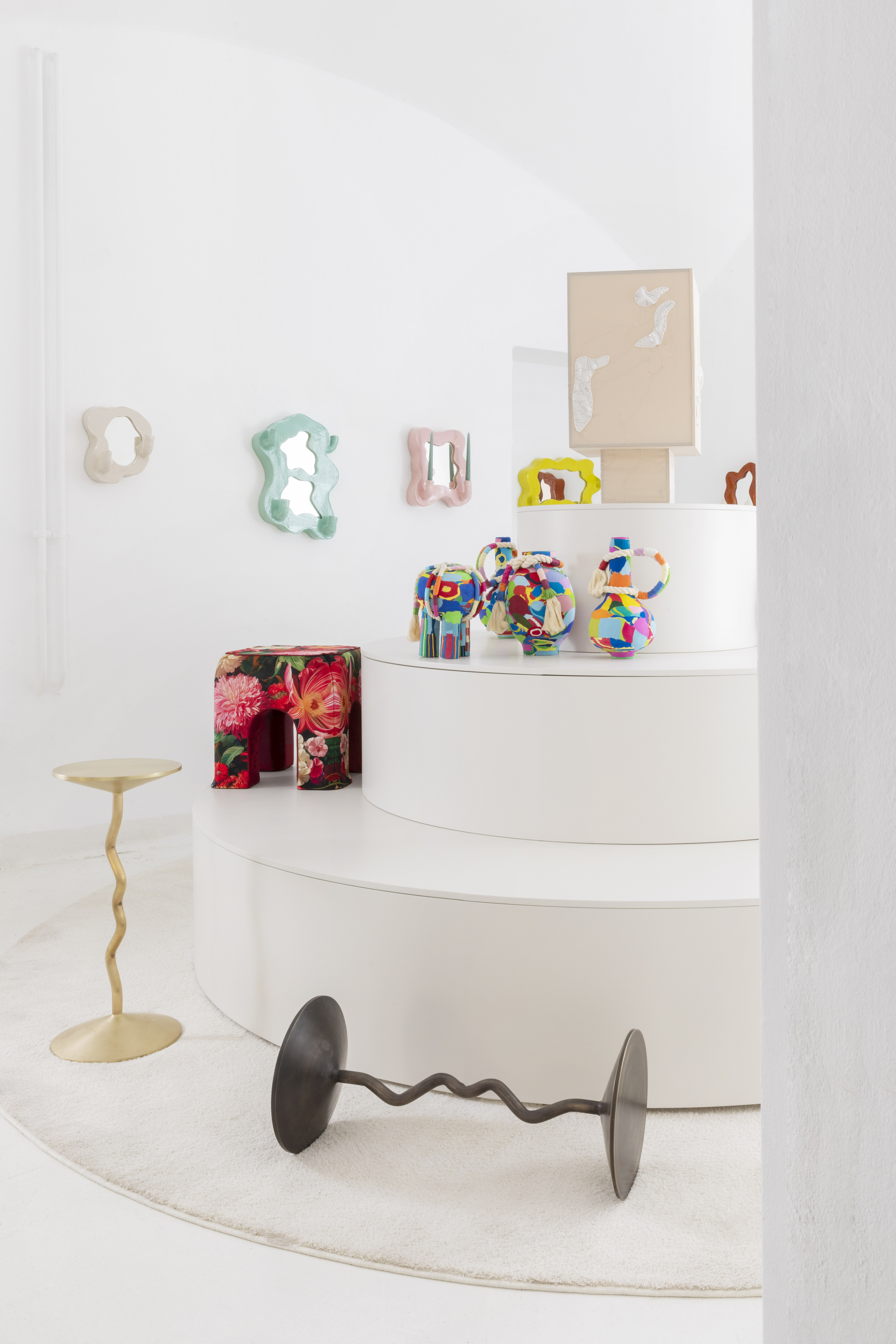2024__Merge__Side Table Collectible Design
![]()
![]()
In Italy, and particularly in the Roman territory, Travertine has always been an identity-bearing stone, an integral part of the material culture and artisanal tradition. Even today, during the processing of this precious material, a significant amount of waste is generated: approximately 40% of the extracted travertine is lost during cutting and finishing phases, resulting in fragments considered marginal compared to standardized blocks.
![]()
![]()
Merge was born from this awareness, collecting the remnants and transforming them into unique elements. In each piece, the memory of the previous narrative remains impressed, renewed and evolved through the material itself.
In a dialogue of contrasts, collaboration, and sustainability, aluminum meets travertine.
It does not disturb or overpower it: it embraces its forms, supports it, and enhances its identity.
The elements strip themselves to dress one another: no longer waste, but living matter, capable of preserving and transforming the memory of its own essence.
category: side table
![]()
![]()
![]()
![]()
Collectible Design
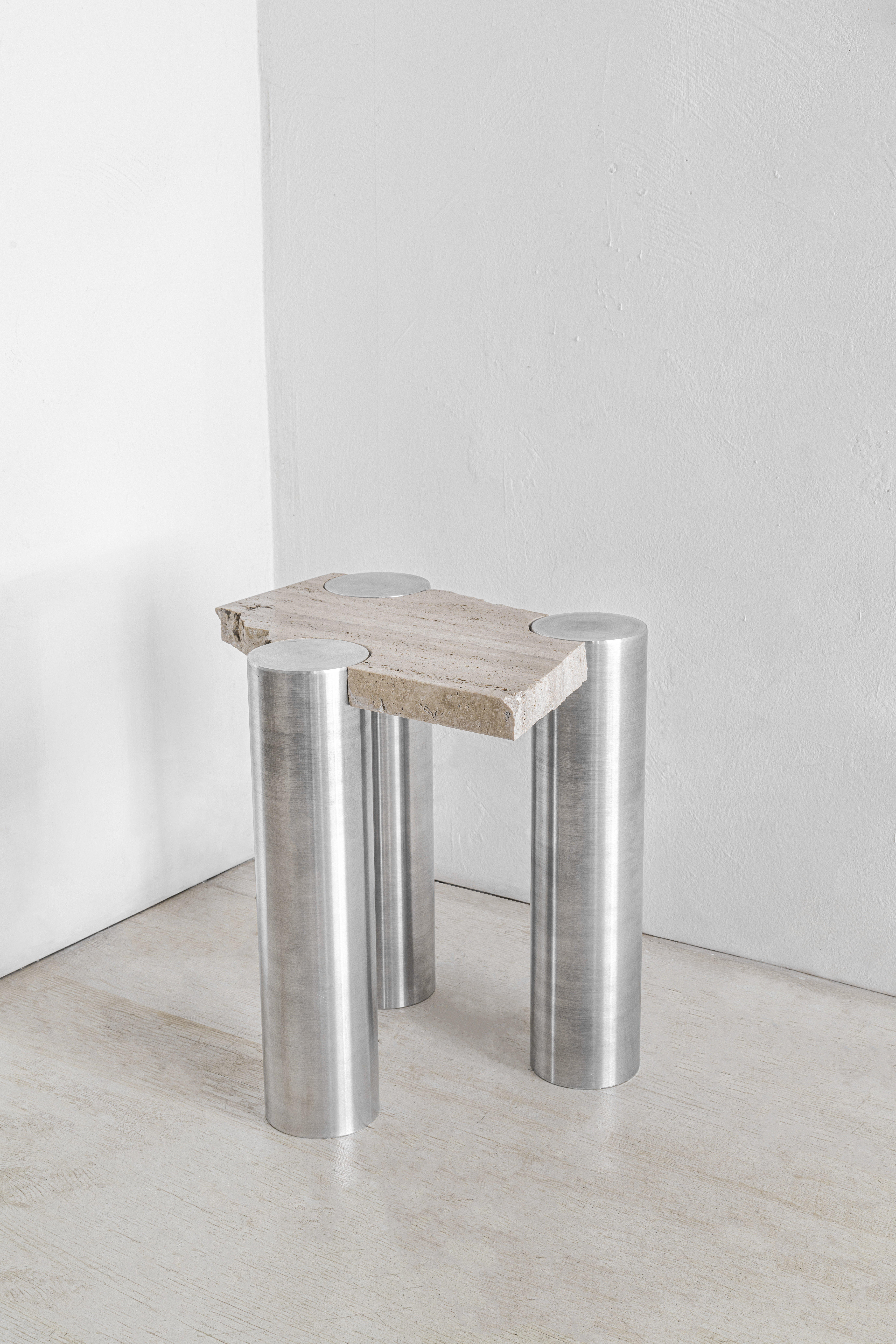
In Italy, and particularly in the Roman territory, Travertine has always been an identity-bearing stone, an integral part of the material culture and artisanal tradition. Even today, during the processing of this precious material, a significant amount of waste is generated: approximately 40% of the extracted travertine is lost during cutting and finishing phases, resulting in fragments considered marginal compared to standardized blocks.
In a dialogue of contrasts, collaboration, and sustainability, aluminum meets travertine.
It does not disturb or overpower it: it embraces its forms, supports it, and enhances its identity.
The elements strip themselves to dress one another: no longer waste, but living matter, capable of preserving and transforming the memory of its own essence.
category: side table
materials: roman travertine and aluminium
dimensions: 45 x 45 x 50h cm
*The product is completely handmade in Italy.
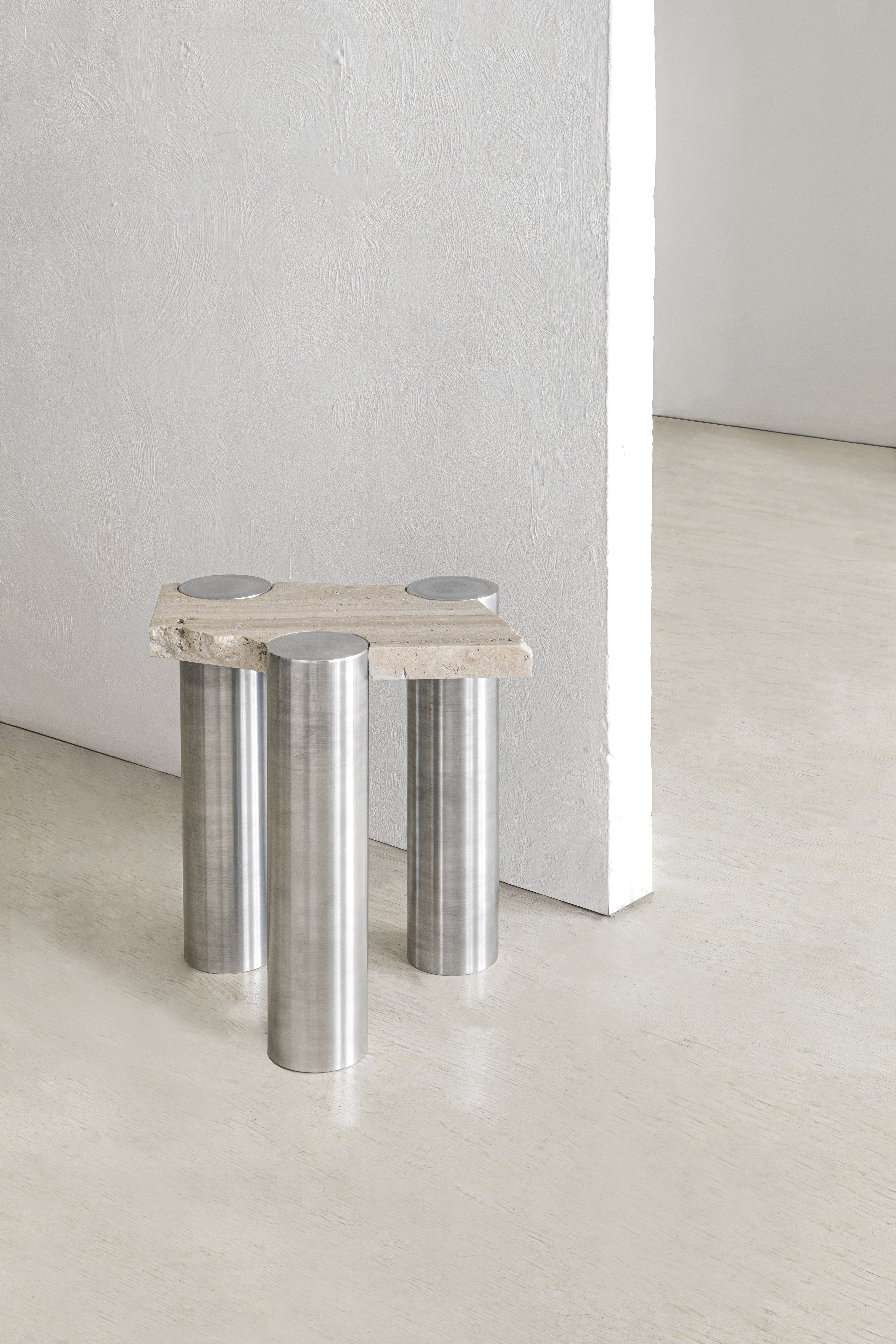
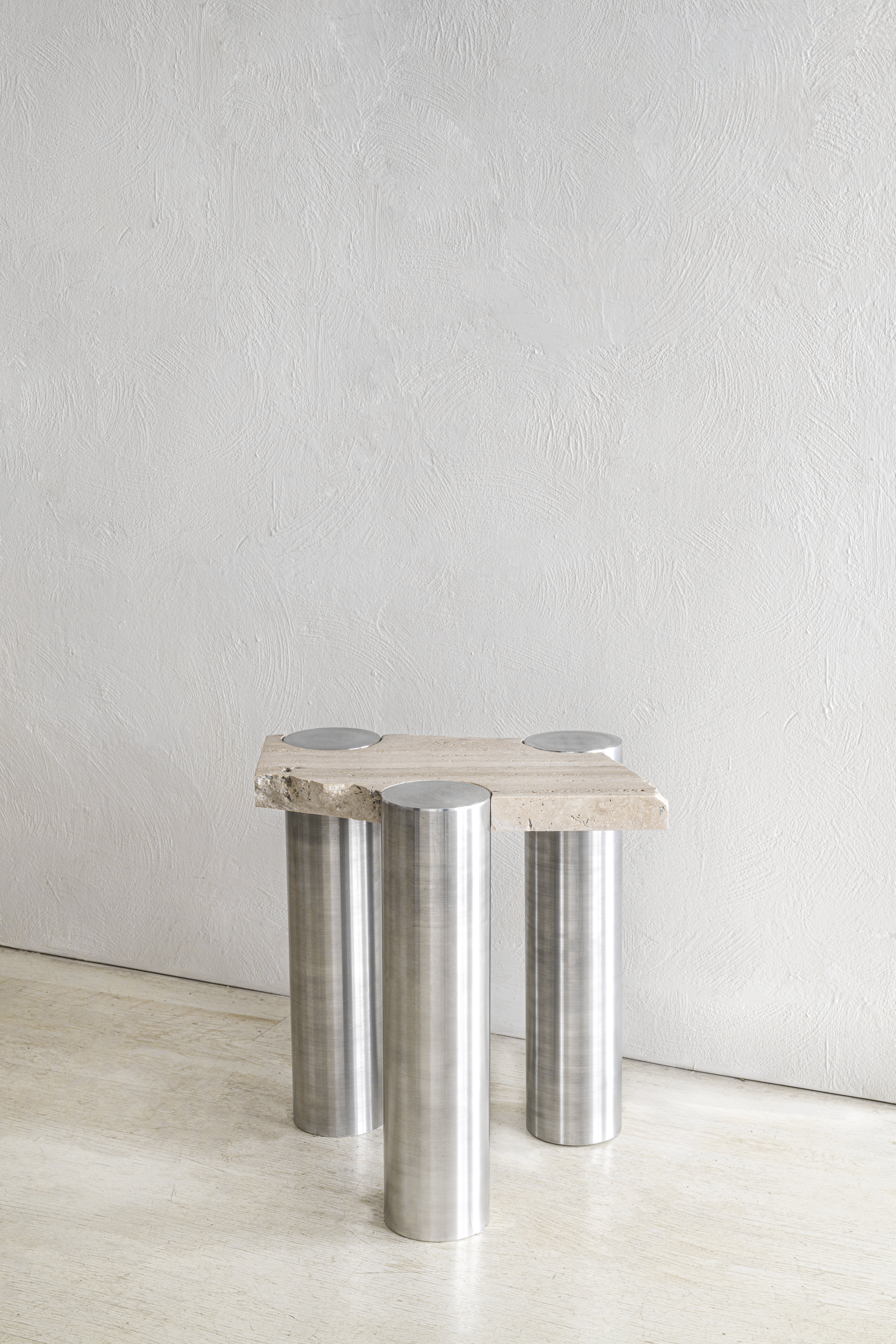
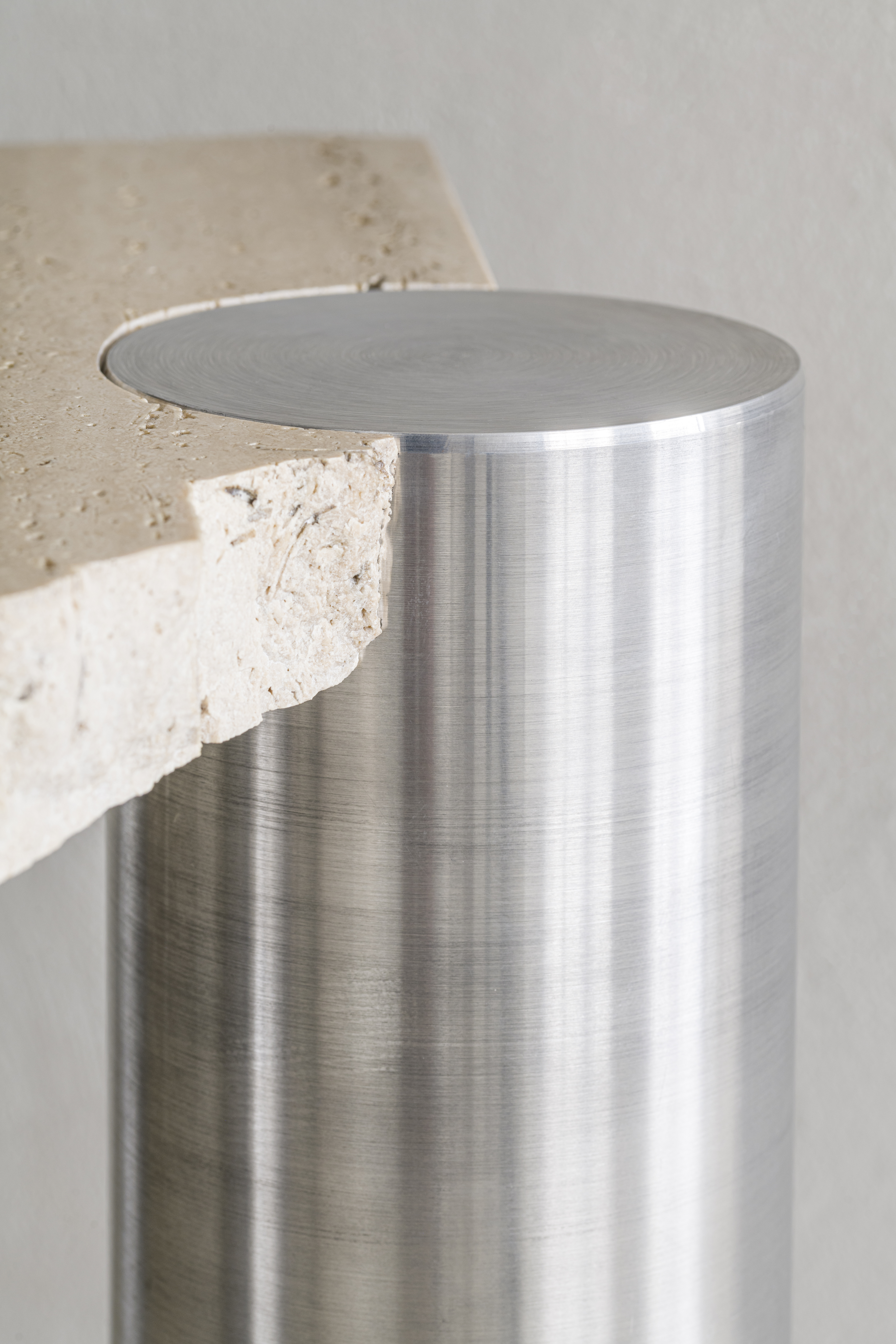
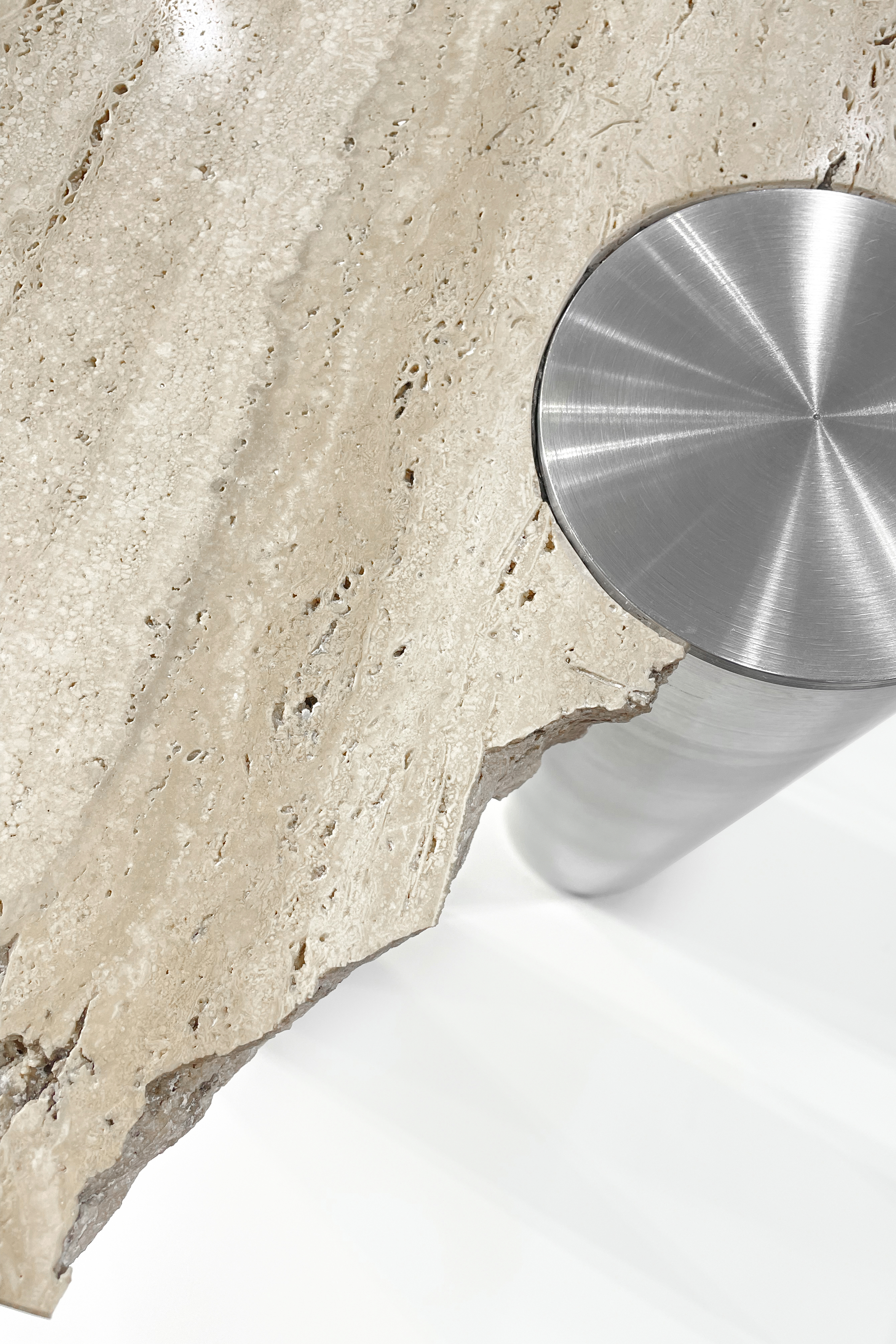
ph: ©Emanuele Chiaverini
2024__CO Series 01__Sculpture/Bookshelf Collectible Design
![]()
![]()
Abandoned forms, rejects of other projects, come back to show themselves in a new life. No more matter in excess but form and essence.
CO Series 01 is an extension of the Cutout project, an aesthetic research on metal shapes that have been cutted out from other projects. Every waste of matter is part of a story.
The variable and free geometries, due to the previous processes, give the sign to each new piece.
category: sculpture / bookshelf
![]()
![]()
![]()
![]()
Collectible Design


Abandoned forms, rejects of other projects, come back to show themselves in a new life. No more matter in excess but form and essence.
CO Series 01 is an extension of the Cutout project, an aesthetic research on metal shapes that have been cutted out from other projects. Every waste of matter is part of a story.
The variable and free geometries, due to the previous processes, give the sign to each new piece.
category: sculpture / bookshelf
materials: black metal sheets
dimensions: 150 x 100 x 160h cm
*The product is completely handmade in Italy.


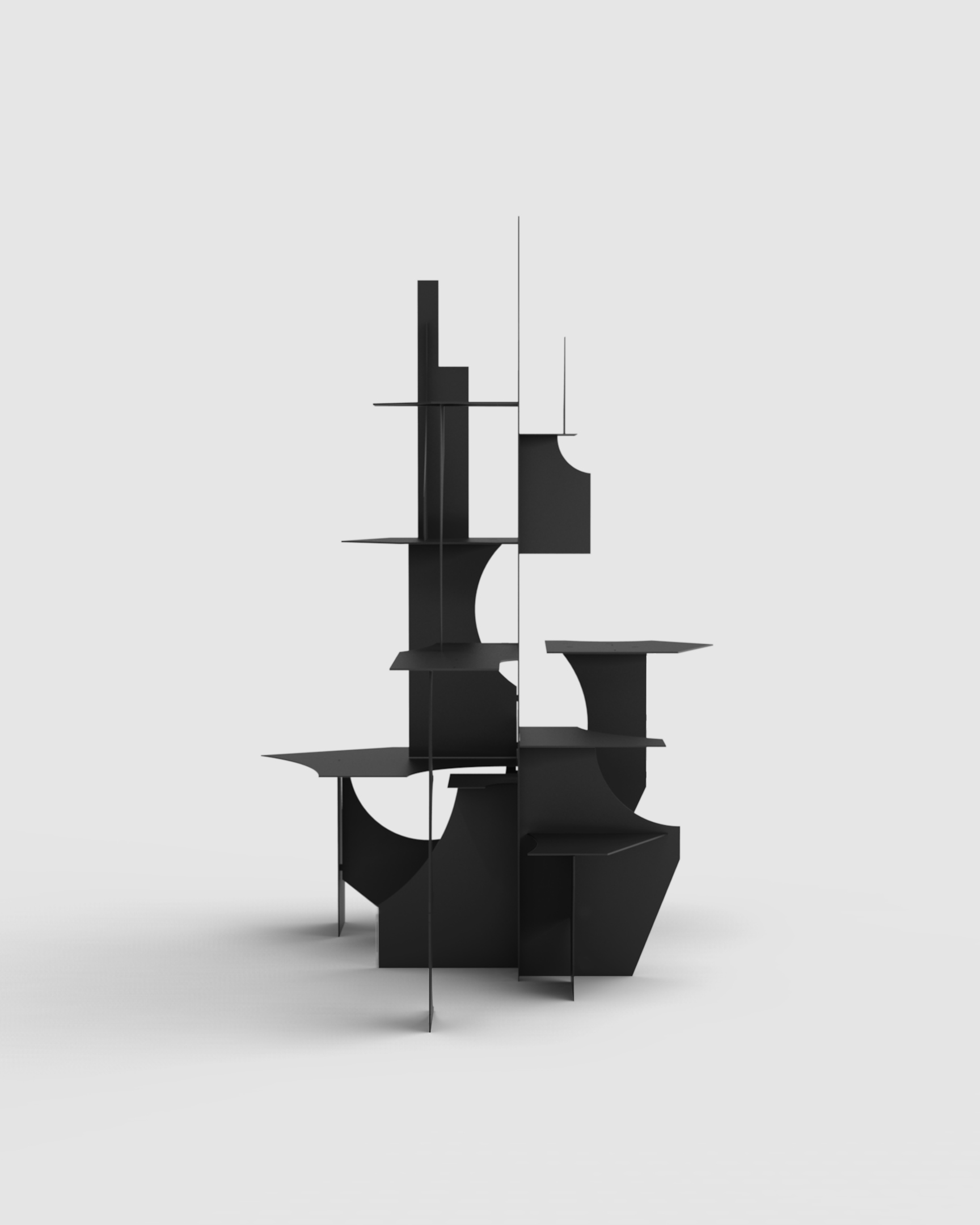

ph: ©Emanuele Chiaverini
2024__Metalique__Side Table Collectible Design
![]()
![]()
The hand-turning process becomes both element and tool of narration, passage, and transformation. The return to the artisanal roots of this ancient decorative technique offers the opportunity to explore a relationship with production whose rhythms are marked by manual dexterity. Metalique strips the material of its original form with the aim of discovering beauty in absence. The products of the collection are characterized by absolute uniqueness as they are the result of human labor and processes not entirely controlled. The turned legs appear both firm and dynamic simultaneously, in a play of light that emphasizes the material's profile. The remnants, aluminum shavings left behind during the process, take on their own individuality as remnants of a unified body, laid at its feet.
category: side tabe
![]()
![]()
Collectible Design
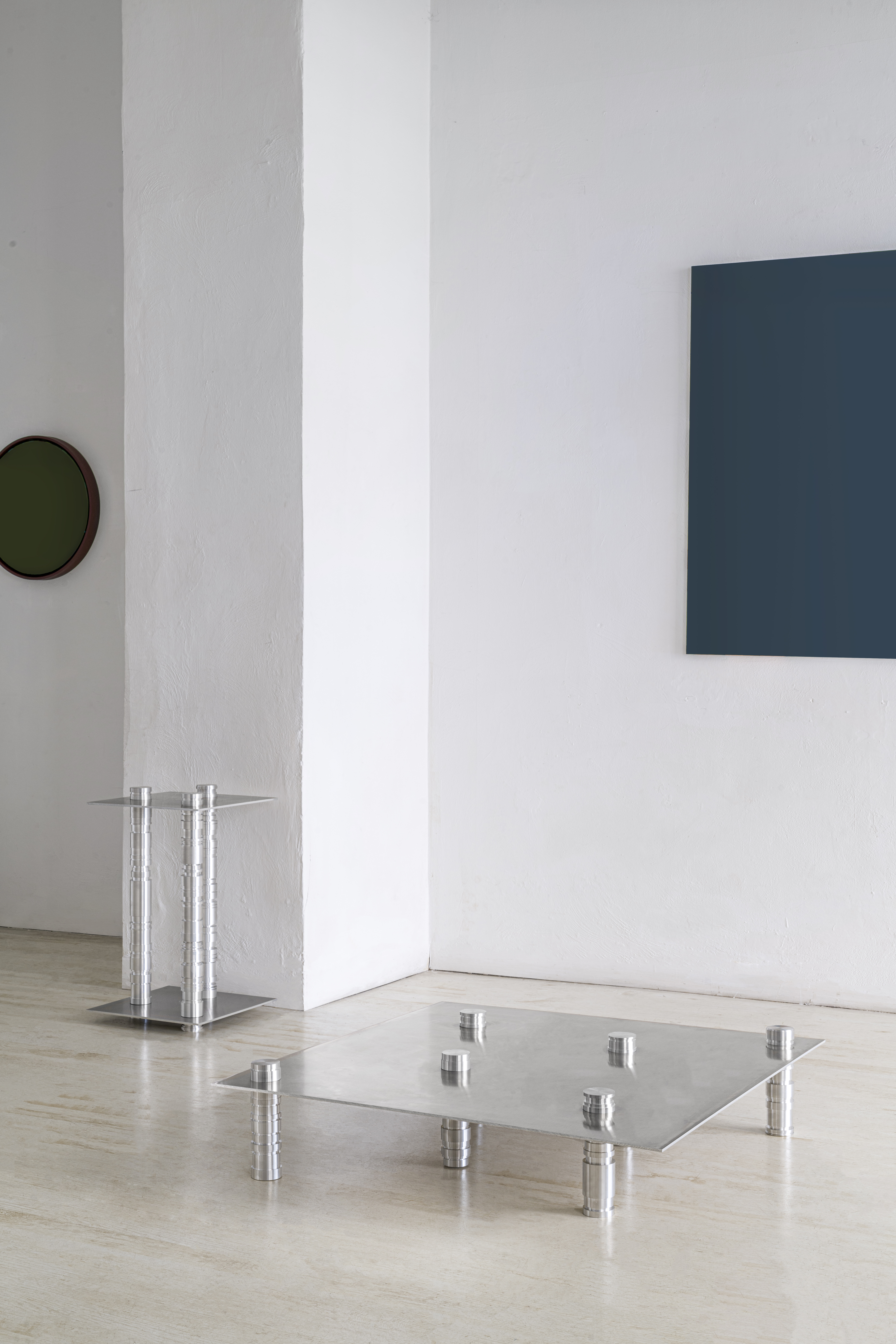

Metalique explores the unrepeatable through subtraction. What is taken away leaves a mark and emphasizes what remains.
The hand-turning process becomes both element and tool of narration, passage, and transformation. The return to the artisanal roots of this ancient decorative technique offers the opportunity to explore a relationship with production whose rhythms are marked by manual dexterity. Metalique strips the material of its original form with the aim of discovering beauty in absence. The products of the collection are characterized by absolute uniqueness as they are the result of human labor and processes not entirely controlled. The turned legs appear both firm and dynamic simultaneously, in a play of light that emphasizes the material's profile. The remnants, aluminum shavings left behind during the process, take on their own individuality as remnants of a unified body, laid at its feet.
category: side tabe
materials: aluminium
dimensions: 40 x 40 x 65h cm
*The product is completely handmade in Italy.


ph: ©Emanuele Chiaverini
2024__Metalique__Bookshelf Collectible Design
![]()
![]()
The hand-turning process becomes both element and tool of narration, passage, and transformation. The return to the artisanal roots of this ancient decorative technique offers the opportunity to explore a relationship with production whose rhythms are marked by manual dexterity. Metalique strips the material of its original form with the aim of discovering beauty in absence. The products of the collection are characterized by absolute uniqueness as they are the result of human labor and processes not entirely controlled. The turned legs appear both firm and dynamic simultaneously, in a play of light that emphasizes the material's profile. The remnants, aluminum shavings left behind during the process, take on their own individuality as remnants of a unified body, laid at its feet.
category: bookshelf
![]()
Collectible Design

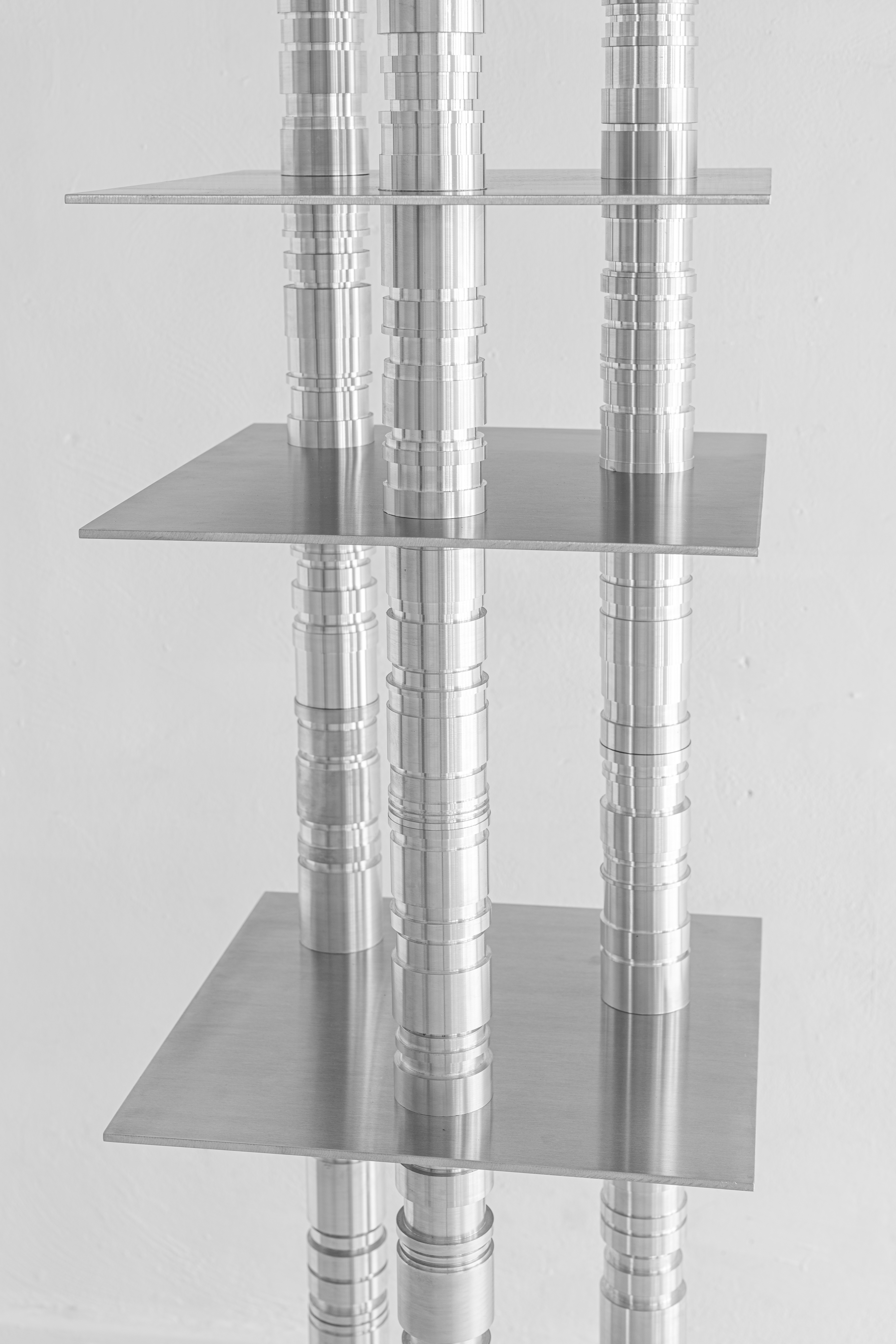
Metalique explores the unrepeatable through subtraction. What is taken away leaves a mark and emphasizes what remains.
The hand-turning process becomes both element and tool of narration, passage, and transformation. The return to the artisanal roots of this ancient decorative technique offers the opportunity to explore a relationship with production whose rhythms are marked by manual dexterity. Metalique strips the material of its original form with the aim of discovering beauty in absence. The products of the collection are characterized by absolute uniqueness as they are the result of human labor and processes not entirely controlled. The turned legs appear both firm and dynamic simultaneously, in a play of light that emphasizes the material's profile. The remnants, aluminum shavings left behind during the process, take on their own individuality as remnants of a unified body, laid at its feet.
category: bookshelf
materials: aluminium
dimensions: 40 x 40 x 170h cm
*The product is completely handmade in Italy.

ph: ©Emanuele Chiaverini
2024__Metalique__Coffee Table Collectible Design
![]()
The hand-turning process becomes both element and tool of narration, passage, and transformation. The return to the artisanal roots of this ancient decorative technique offers the opportunity to explore a relationship with production whose rhythms are marked by manual dexterity. Metalique strips the material of its original form with the aim of discovering beauty in absence. The products of the collection are characterized by absolute uniqueness as they are the result of human labor and processes not entirely controlled. The turned legs appear both firm and dynamic simultaneously, in a play of light that emphasizes the material's profile. The remnants, aluminum shavings left behind during the process, take on their own individuality as remnants of a unified body, laid at its feet.
category: coffee table
![]()
![]()
Collectible Design

Metalique explores the unrepeatable through subtraction. What is taken away leaves a mark and emphasizes what remains.
The hand-turning process becomes both element and tool of narration, passage, and transformation. The return to the artisanal roots of this ancient decorative technique offers the opportunity to explore a relationship with production whose rhythms are marked by manual dexterity. Metalique strips the material of its original form with the aim of discovering beauty in absence. The products of the collection are characterized by absolute uniqueness as they are the result of human labor and processes not entirely controlled. The turned legs appear both firm and dynamic simultaneously, in a play of light that emphasizes the material's profile. The remnants, aluminum shavings left behind during the process, take on their own individuality as remnants of a unified body, laid at its feet.
category: coffee table
materials: aluminium
dimensions: 120 x 60 x 45h cm
*The product is completely handmade in Italy.
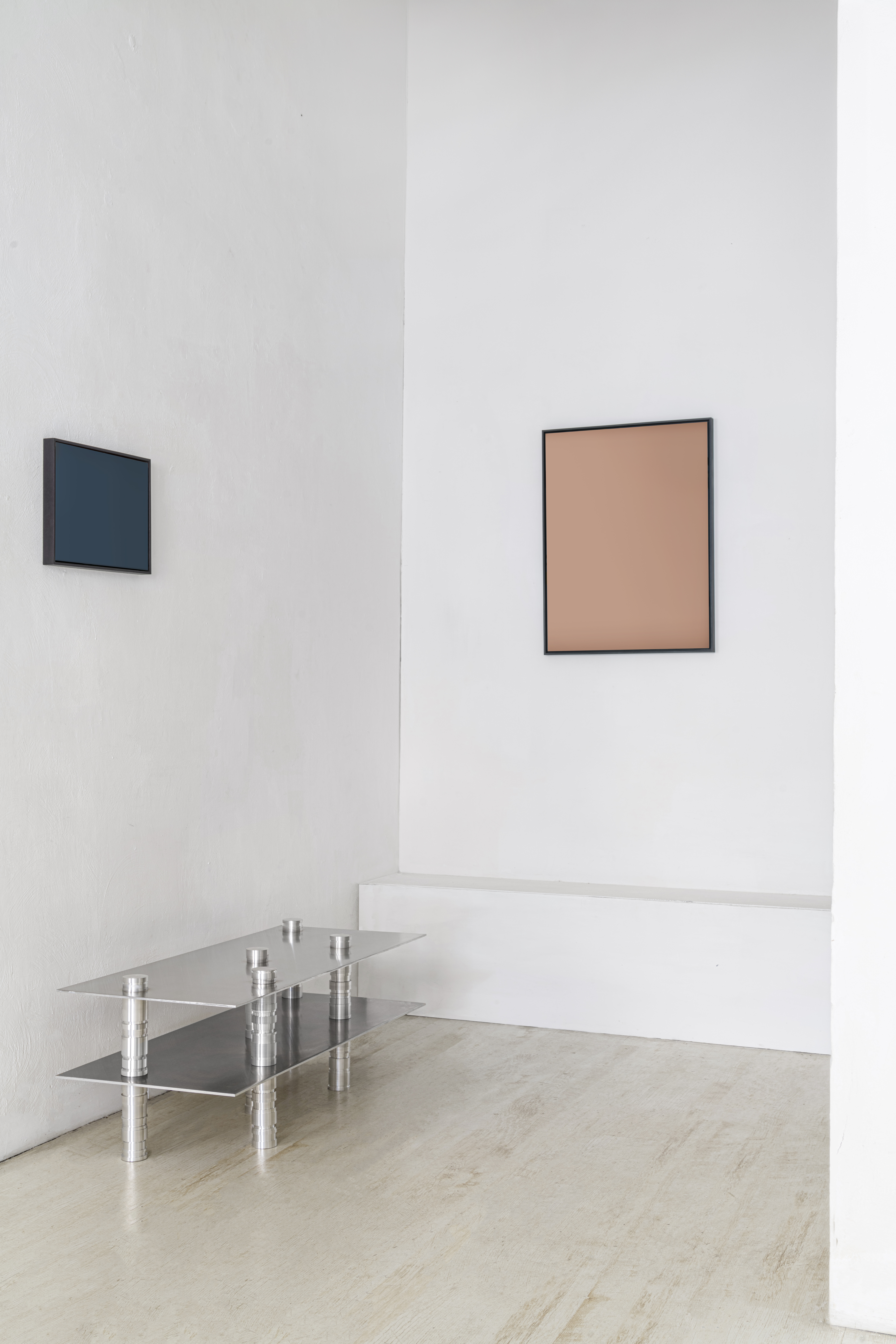
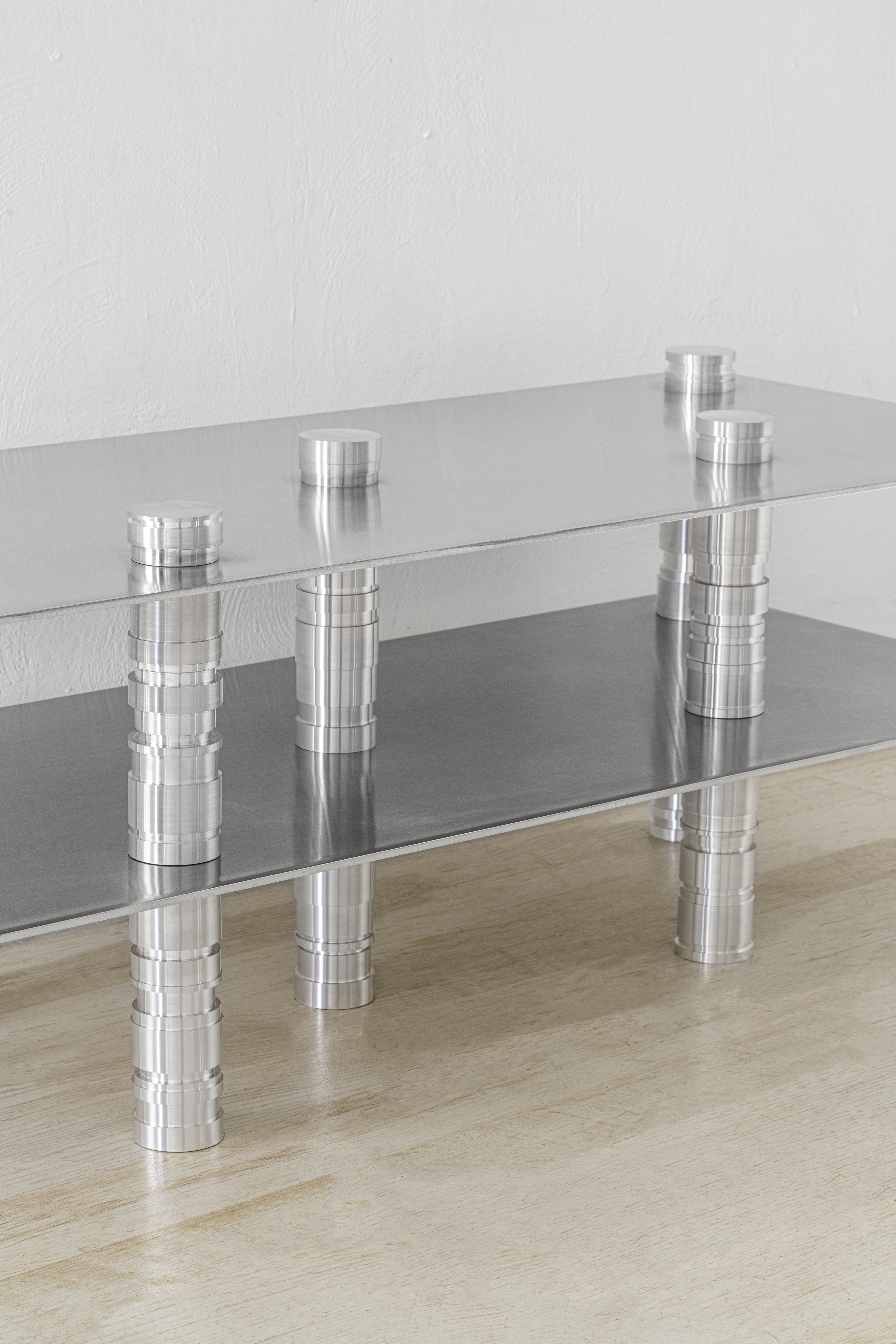
ph: ©Emanuele Chiaverini
2025__Landing__Tramandars Design Collaborations
![]()
The project is an homage to Vesuvius: mother mountain, generator, and guardian of transformation. Each form holds the memory of fire, the echo of an energy that refuses to be tamed.
category: lamp
![]()
Landing was conceived for Tramandars during the 3rd Edition of Art Summit – Vesuvio Contemporary Experience and Residency in Somma Vesuviana, and on the occasion of the Vesuvius Biennale. Within this context, Millim Studio, together with other designers and artists, was invited to engage in a deep dialogue with the territory, offering not merely a product but a narrative: the portrait of a land in constant transformation, yet profoundly devoted to its roots.
Every land holds the substance of who we are: a heritage that takes shape through matter, flowing like blood through veins, rising like untamed lava. Through the metal casting process, Millim Studio sought to honour this primordial bond, a relationship built on transitions, unpredictability, form, and memory. Landing becomes a fragment of landscape, a point of arrival, the reflection of a collective identity that evolves without ever losing sight of its origin.
![]()
![]()
![]()
![]()
![]()
![]()
![]()
Design Collaborations

Born from fire, aluminum becomes a tale of matter and untamed essence. In the act of casting, the metal surrenders to the unexpected, flowing like living lava.
The project is an homage to Vesuvius: mother mountain, generator, and guardian of transformation. Each form holds the memory of fire, the echo of an energy that refuses to be tamed.
category: lamp
materials: casting aluminium
dimensions: 120 x 30h cm
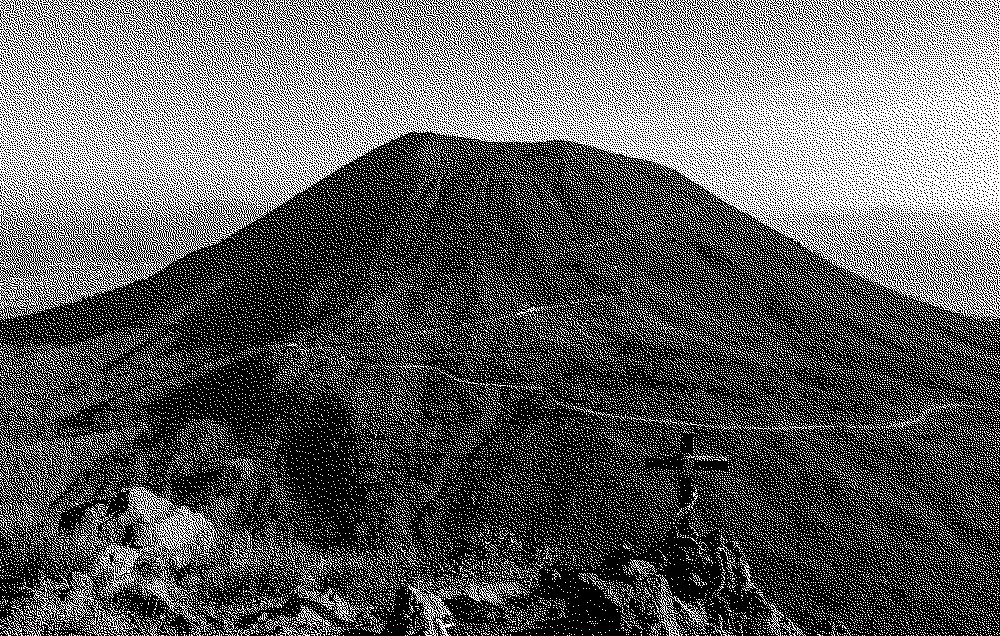
Landing was conceived for Tramandars during the 3rd Edition of Art Summit – Vesuvio Contemporary Experience and Residency in Somma Vesuviana, and on the occasion of the Vesuvius Biennale. Within this context, Millim Studio, together with other designers and artists, was invited to engage in a deep dialogue with the territory, offering not merely a product but a narrative: the portrait of a land in constant transformation, yet profoundly devoted to its roots.
Every land holds the substance of who we are: a heritage that takes shape through matter, flowing like blood through veins, rising like untamed lava. Through the metal casting process, Millim Studio sought to honour this primordial bond, a relationship built on transitions, unpredictability, form, and memory. Landing becomes a fragment of landscape, a point of arrival, the reflection of a collective identity that evolves without ever losing sight of its origin.
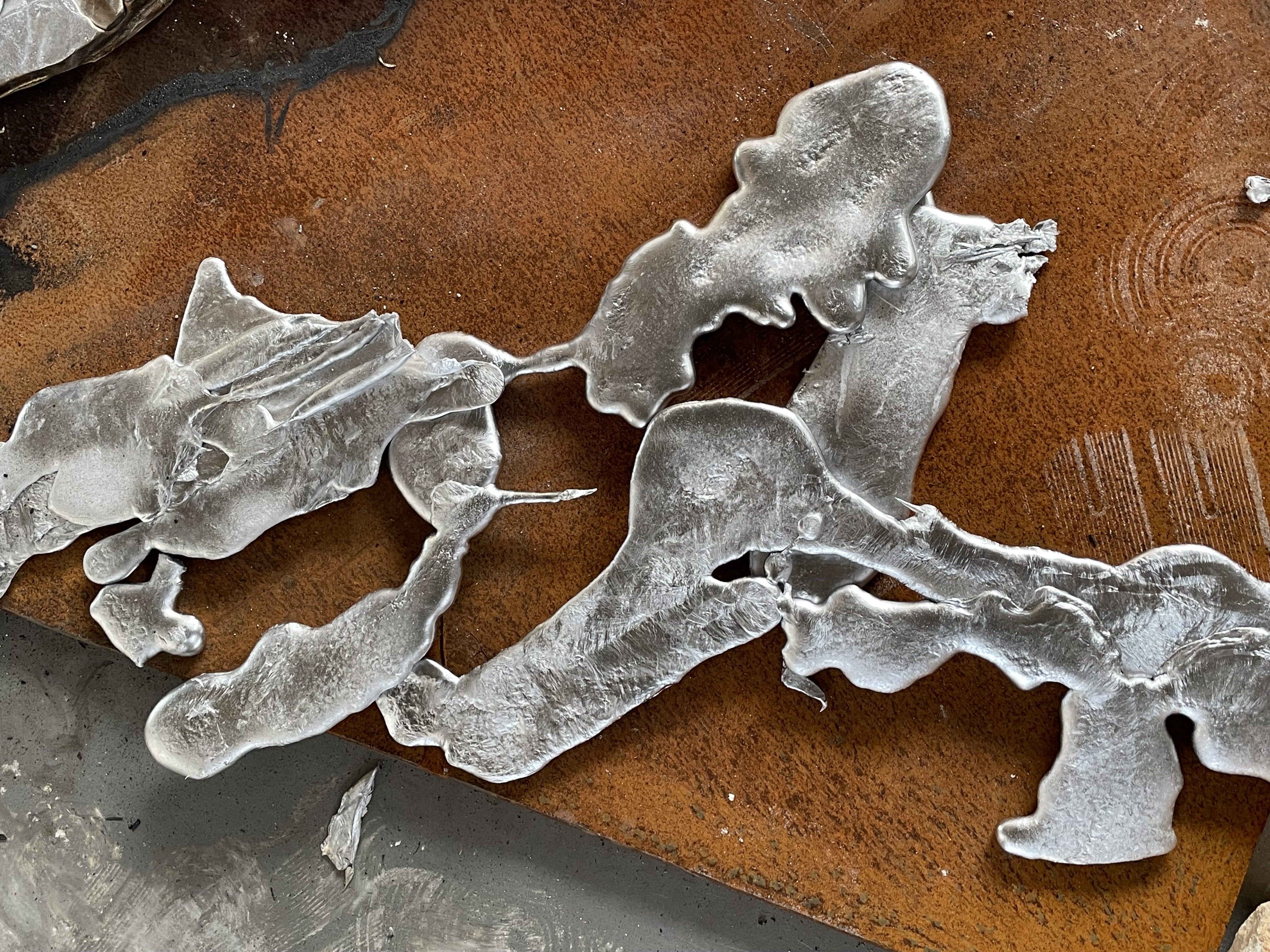


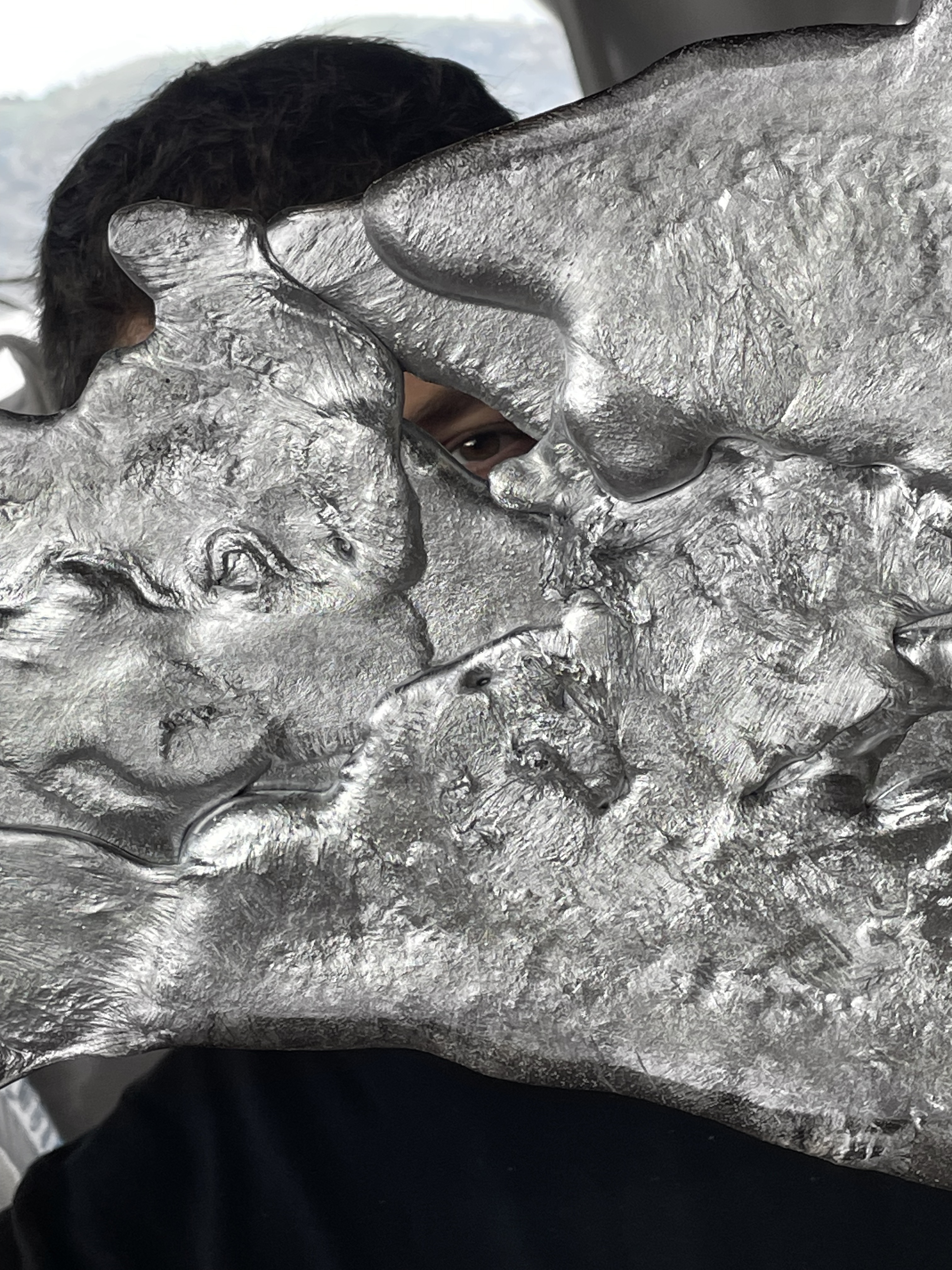



ph: ©Eller Studio ©Millim Studio
www.ruffino.com
2025__Omnes__Ruffino Design Collaborations
![]()
Matter upon matter, in a weave of forms and connections. The work explores stitching as a principle of union, giving “gold” a dual meaning: structure as well as ornament. The bench is a composition of separate elements bound without constraints, allowing for free use. The absence of hierarchy is an invitation for spontaneous interaction, which turns sitting into an experience of balance and relationship.
category: bench
![]()
![]()
![]()
![]()
![]()
Design Collaborations

The beauty of conviviality lies in the encounter of different identities, united by one shared moment. Though distinct, such identities influence each other, thus leaving traces behind.
Matter upon matter, in a weave of forms and connections. The work explores stitching as a principle of union, giving “gold” a dual meaning: structure as well as ornament. The bench is a composition of separate elements bound without constraints, allowing for free use. The absence of hierarchy is an invitation for spontaneous interaction, which turns sitting into an experience of balance and relationship.
category: bench
materials: aluminium and brass
dimensions: 225 x 45 x 40h cm





ph: ©Eller Studio ©Francesco Marano
www.ruffino.com
2025__Balance__Secondome Design Collaborations
![]()
Beyond imagination, within the possible.
With a nod to Italo Calvino’s Le cosmicomiche, where the everyday experiences of humans are playfully and humorously transposed into an imaginary universe without abandoning the search for meaning, Balance is the result of an exercise born from the imagination of possibilities. A conceptual abstraction translated into everyday life through new forms, suggesting yet never defining, leaving behind a radical question: "What if it were possible?”. A stool in form, a side table in aspiration, a barbell in abstraction, and open to infinite interpretations.
category: stools / barbell / side table
![]()
![]()
![]()
![]()
![]()
![]()
![]()
Design Collaborations

Beyond imagination, within the possible.
With a nod to Italo Calvino’s Le cosmicomiche, where the everyday experiences of humans are playfully and humorously transposed into an imaginary universe without abandoning the search for meaning, Balance is the result of an exercise born from the imagination of possibilities. A conceptual abstraction translated into everyday life through new forms, suggesting yet never defining, leaving behind a radical question: "What if it were possible?”. A stool in form, a side table in aspiration, a barbell in abstraction, and open to infinite interpretations.
“At the bottom of each of those eyes I lived, or rather another me lived, one of the images of me”
Italo Calvino, Le cosmicomiche, 1965category: stools / barbell / side table
materials: bronze
dimensions: 35 x 35 x 63h cm

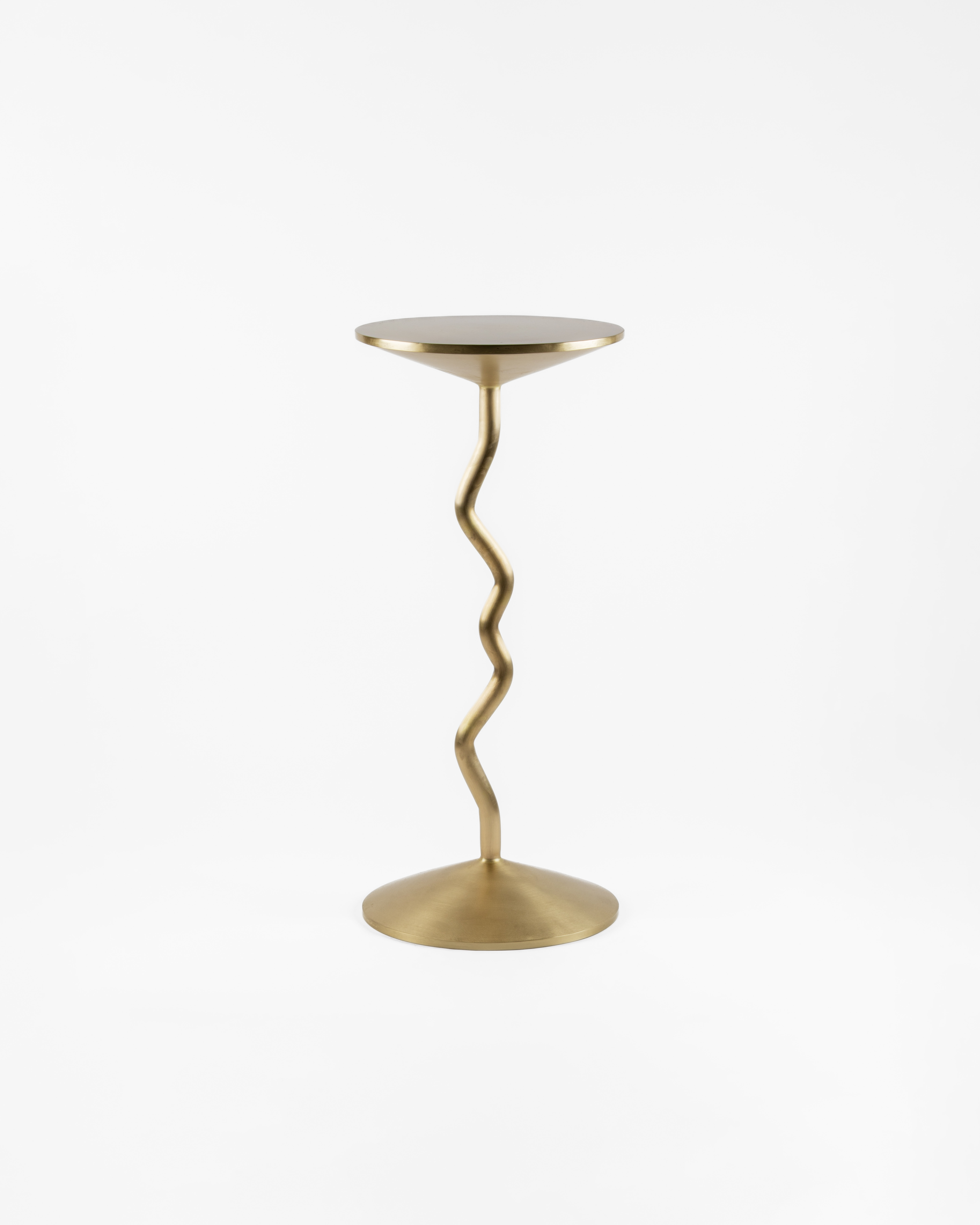





ph: ©Eller Studio ©Serena Eller
2024__Culto Chair__Ferrantelli
Design Collaborations
![]()
![]()
![]()
![]()
![]()
![]()
![]()
Cult is the connection between the earthly and the divine, the relationship with what is sacred, and the expression of customs and gestures through which religious sentiment manifests itself.
Every ritual is marked by gestures performed at a specific time and in a specific way. Movements that become an integral part of the ritual, like a universal dance. An object that is communal yet, at the same time, singular.
![]()
![]()
![]()
Design Collaborations


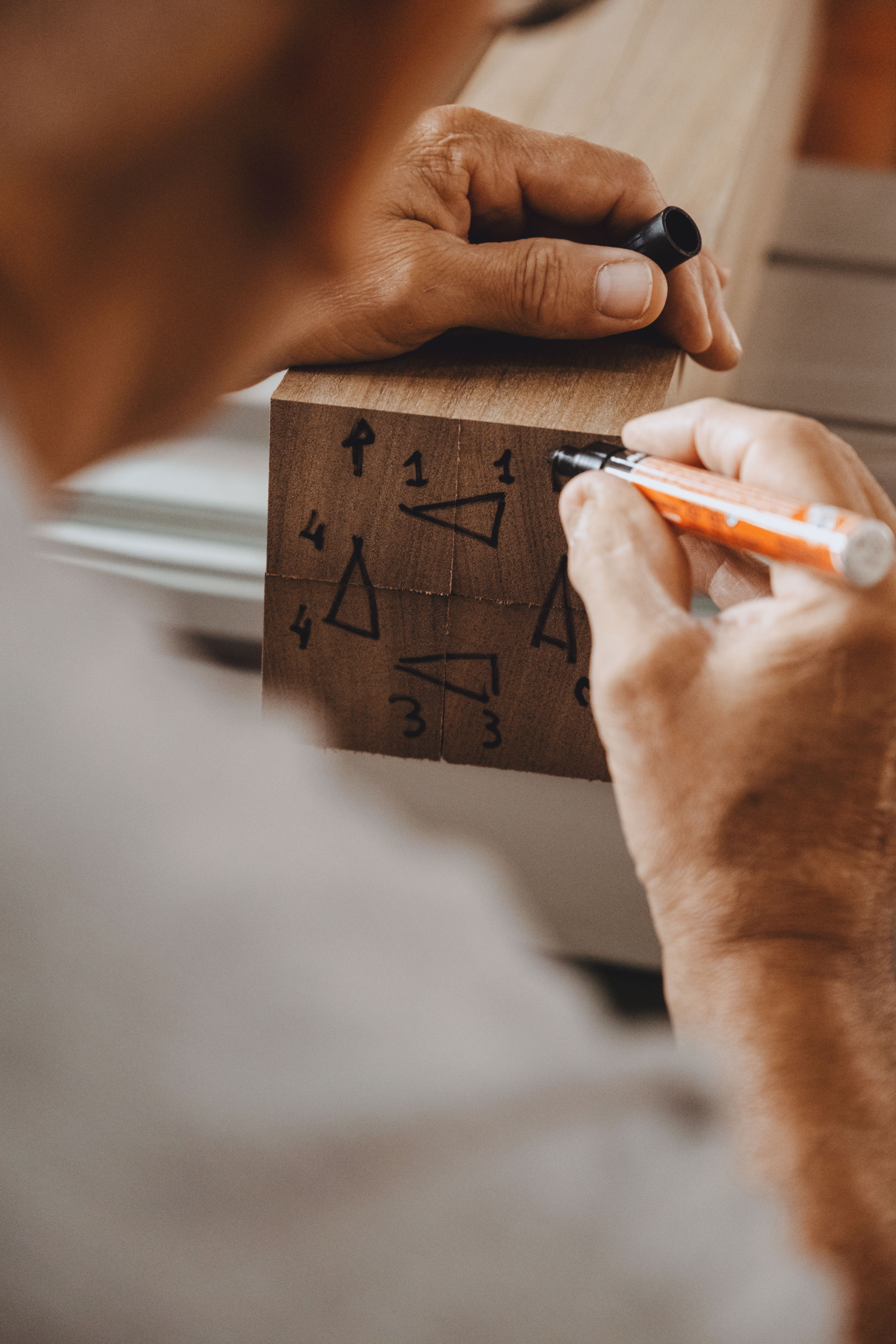
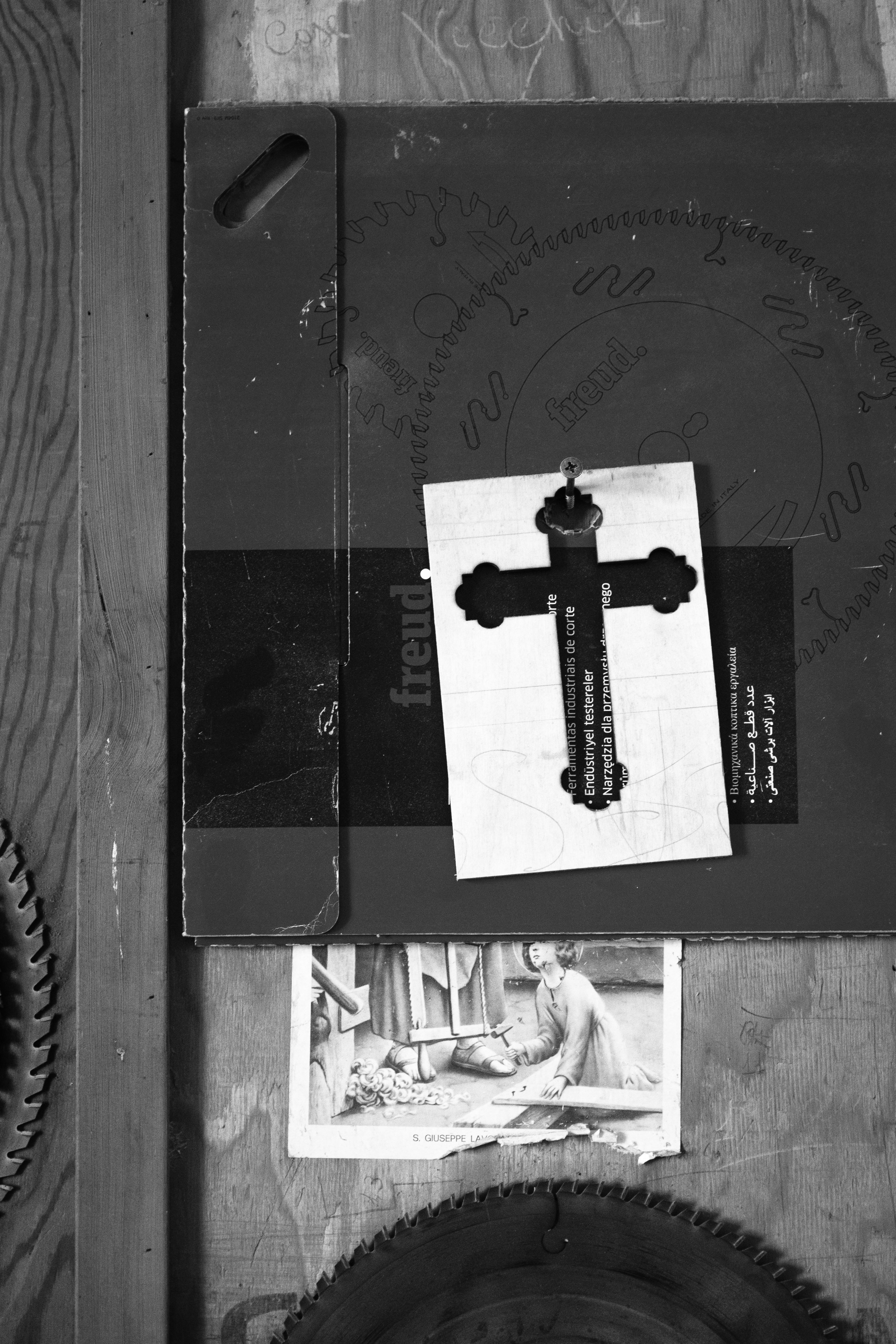
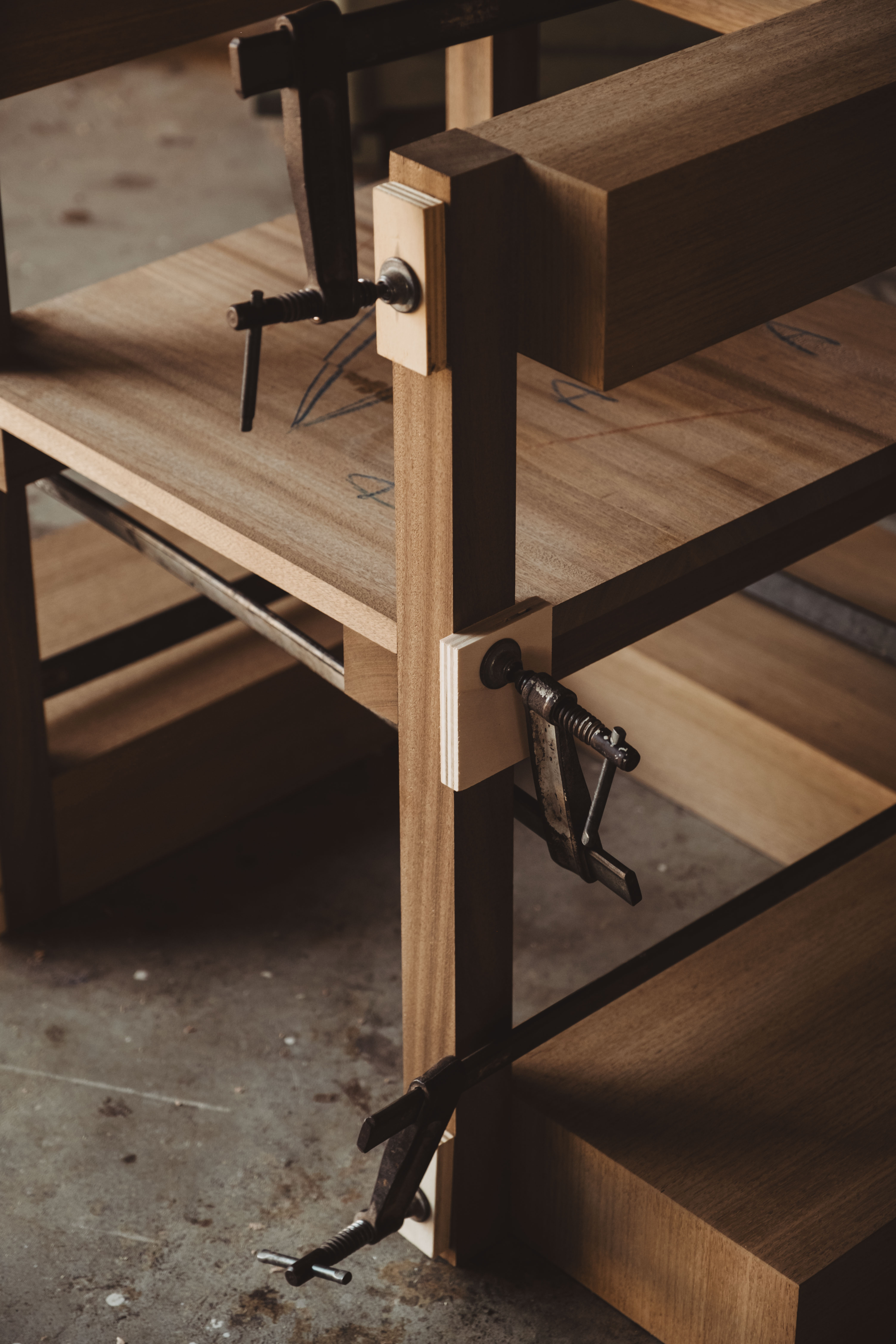

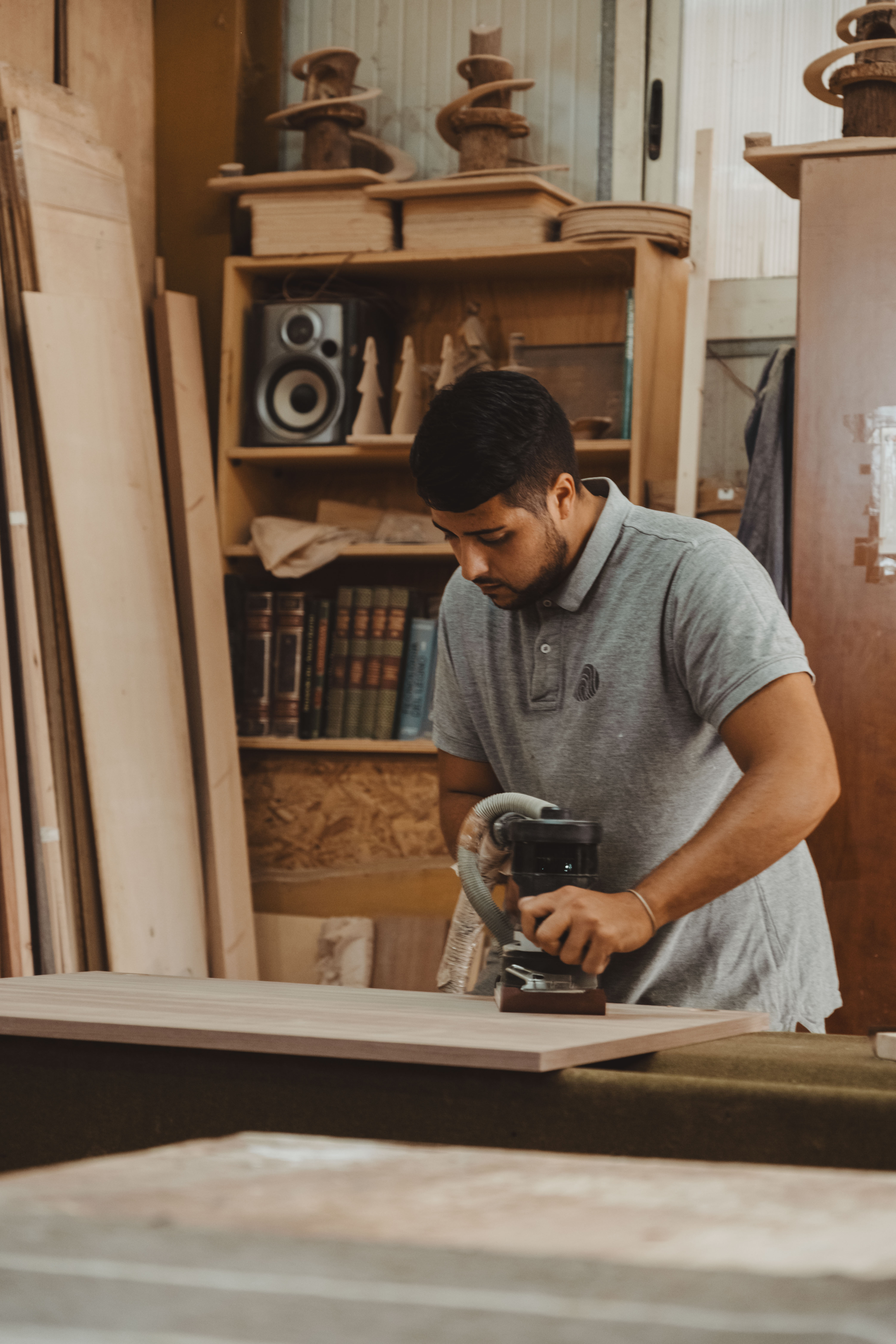
Cult is the connection between the earthly and the divine, the relationship with what is sacred, and the expression of customs and gestures through which religious sentiment manifests itself.
Every ritual is marked by gestures performed at a specific time and in a specific way. Movements that become an integral part of the ritual, like a universal dance. An object that is communal yet, at the same time, singular.
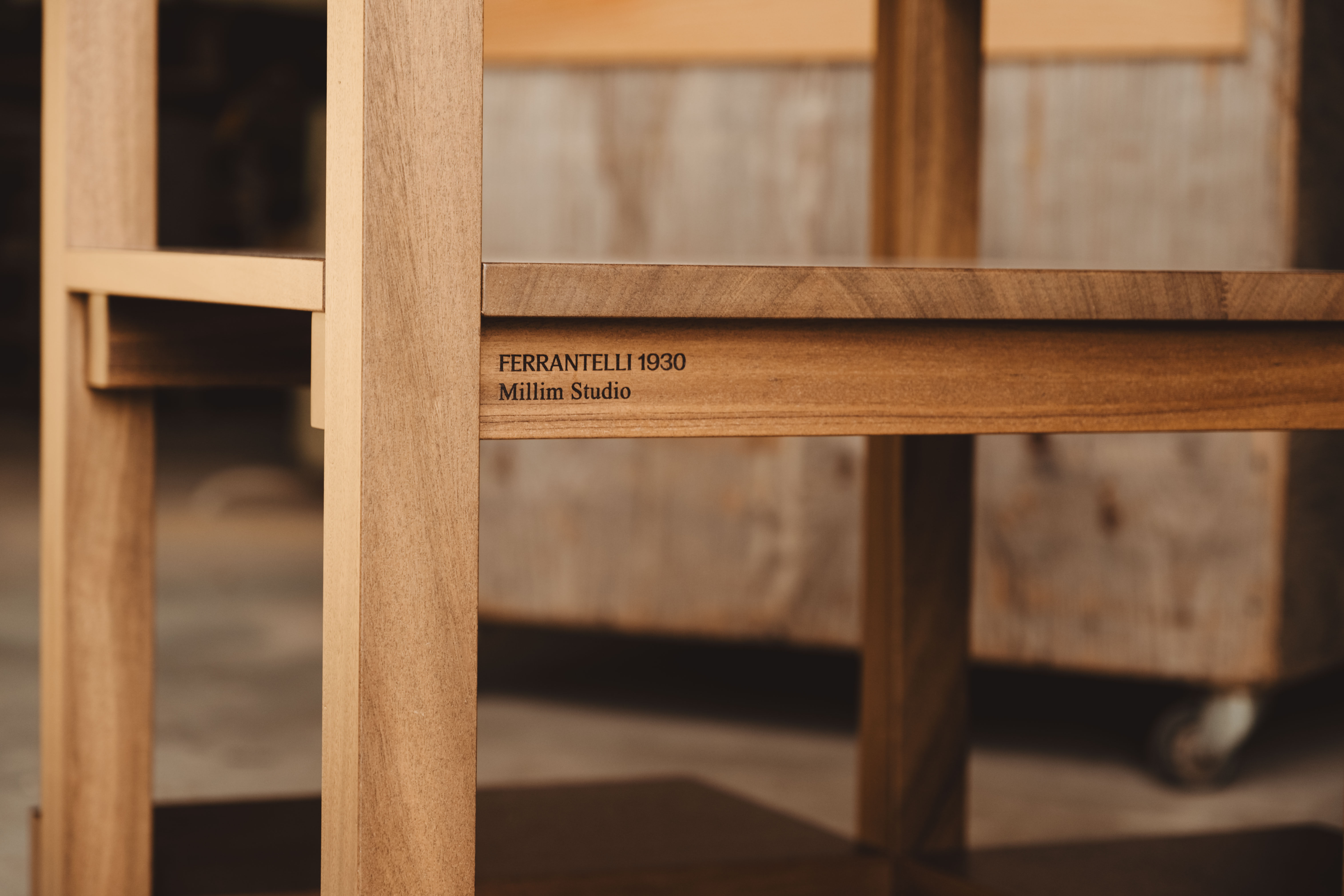
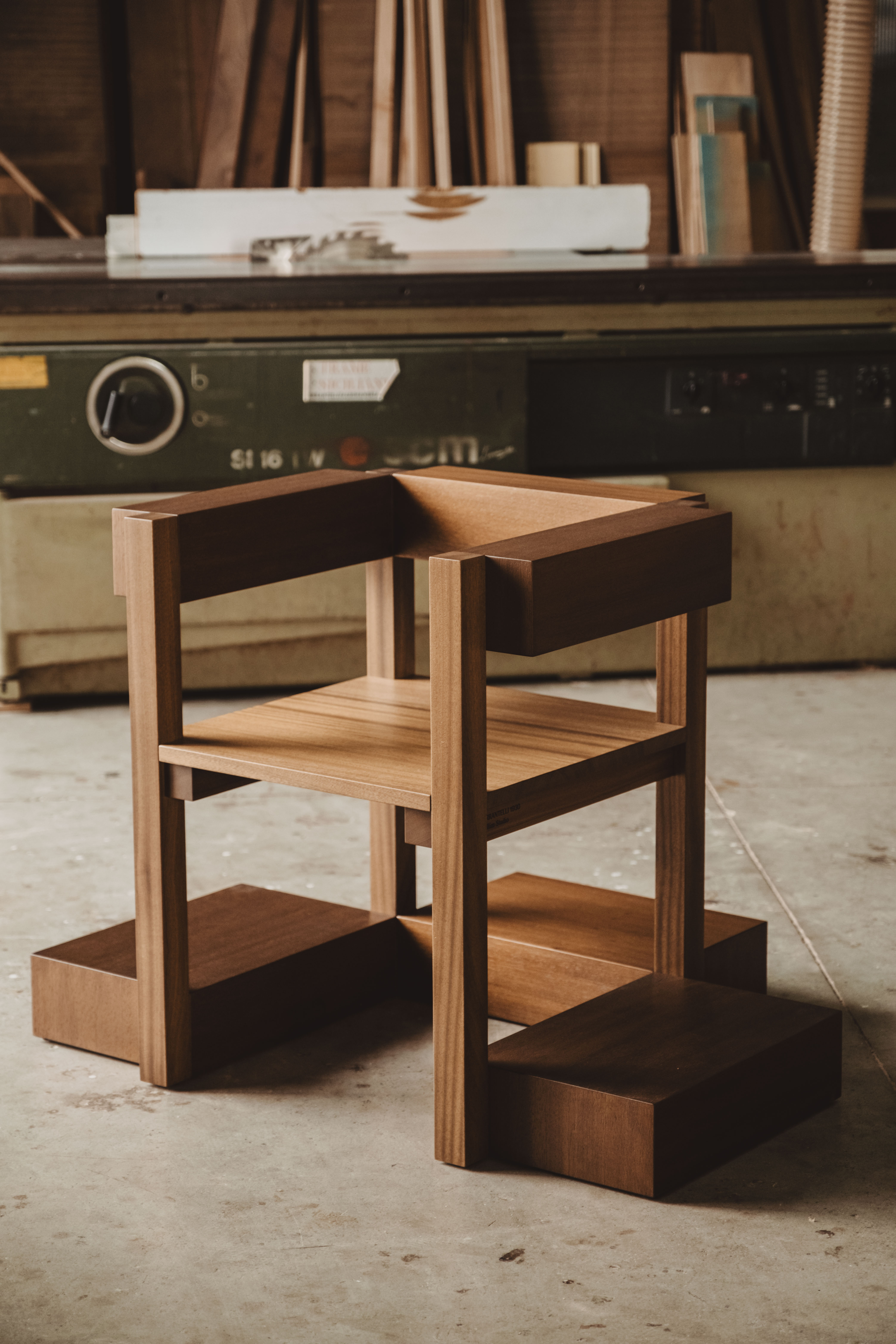

ph: ©Chiara Pugliesi
2021__Alter__Studio F Design Collaborations
![]()
Declare the intrinsic strength of the form, in order to make it essential and functional to itself.
“Classic” geometrics and volumes capable of leading us on the course of continuous research and cultural connection between past, present and future.
Investigating the current concept of aggregation, "Alter" becomes the formal representation of the multiplicity, diversity and complexity of tangible and intangible connections to which we are very familiar today.
The idea of the project is to develop a product that is a sign of our times, but which at the same time can extend cultural and social meanings and values, even after years.
Studio F focuses its work on the importance of solid wood and its recovery. The selected wood is a centennial Cedar charred with the Japanese technique of Shou Sugi Ban.
"Alter" wants to be the expression of a broken down and unstructured coffee table, modifying the formal and canonical image of the elements that contribute to the construction of a table. "Alter" is a "fluid" product in which the concept of "leg" and "floor" is lost.
An "other" table that evolves in its simplicity, becoming an emblem of bond, support, aggregation and comparison for distinct elements. The top loses its function as a surface above the legs, to become a welcoming line. Each element of "Alter" acquires its own identity but at the same time is a fundamental part in the construction of the whole, contributing to its balance, its union and essence.
Design: Millim Studio
![]()
![]()
![]()
Design Collaborations
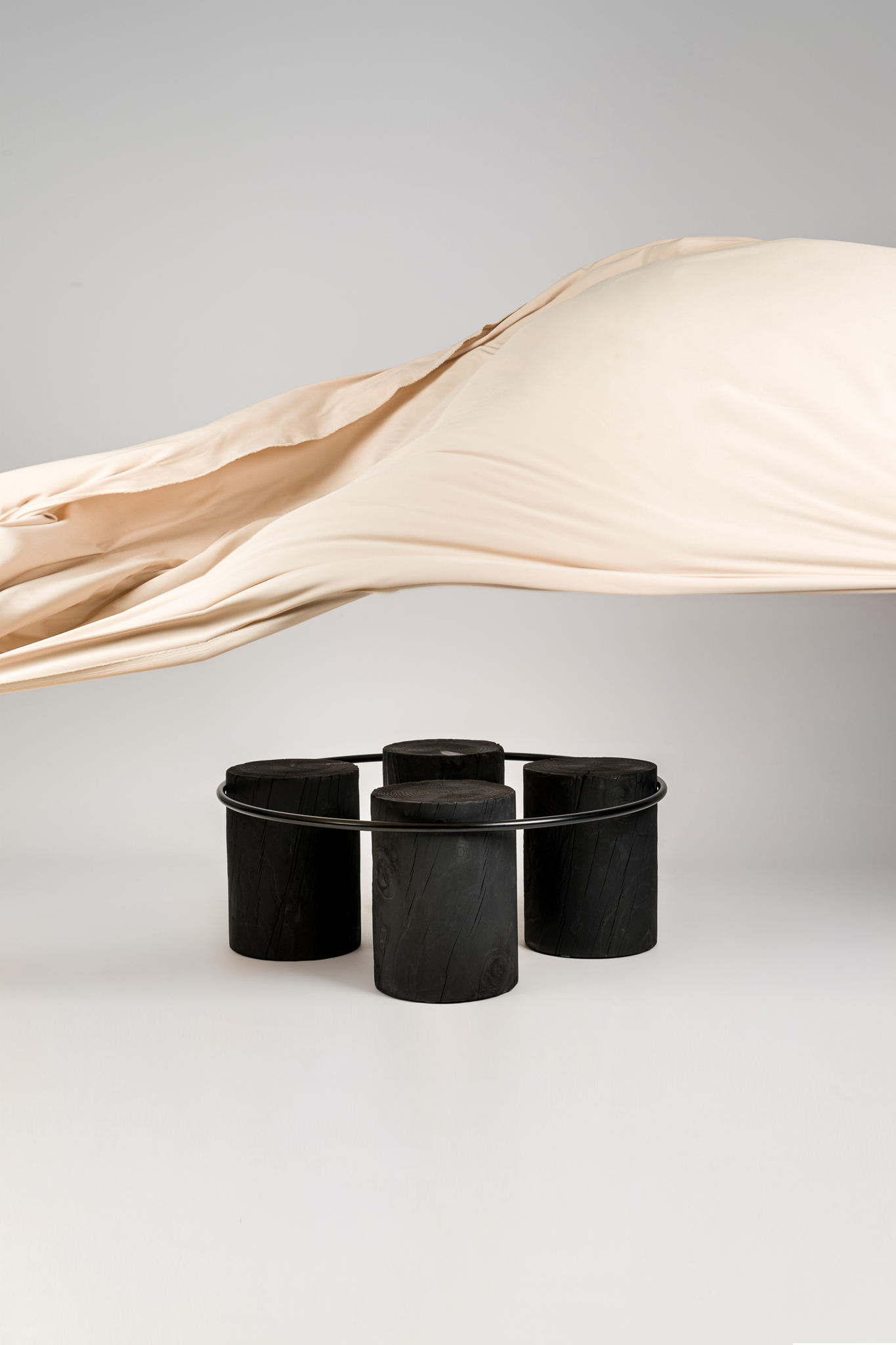
Declare the intrinsic strength of the form, in order to make it essential and functional to itself.
“Classic” geometrics and volumes capable of leading us on the course of continuous research and cultural connection between past, present and future.
Investigating the current concept of aggregation, "Alter" becomes the formal representation of the multiplicity, diversity and complexity of tangible and intangible connections to which we are very familiar today.
The idea of the project is to develop a product that is a sign of our times, but which at the same time can extend cultural and social meanings and values, even after years.
Studio F focuses its work on the importance of solid wood and its recovery. The selected wood is a centennial Cedar charred with the Japanese technique of Shou Sugi Ban.
"Alter" wants to be the expression of a broken down and unstructured coffee table, modifying the formal and canonical image of the elements that contribute to the construction of a table. "Alter" is a "fluid" product in which the concept of "leg" and "floor" is lost.
An "other" table that evolves in its simplicity, becoming an emblem of bond, support, aggregation and comparison for distinct elements. The top loses its function as a surface above the legs, to become a welcoming line. Each element of "Alter" acquires its own identity but at the same time is a fundamental part in the construction of the whole, contributing to its balance, its union and essence.
Design: Millim Studio
Production: Studio F
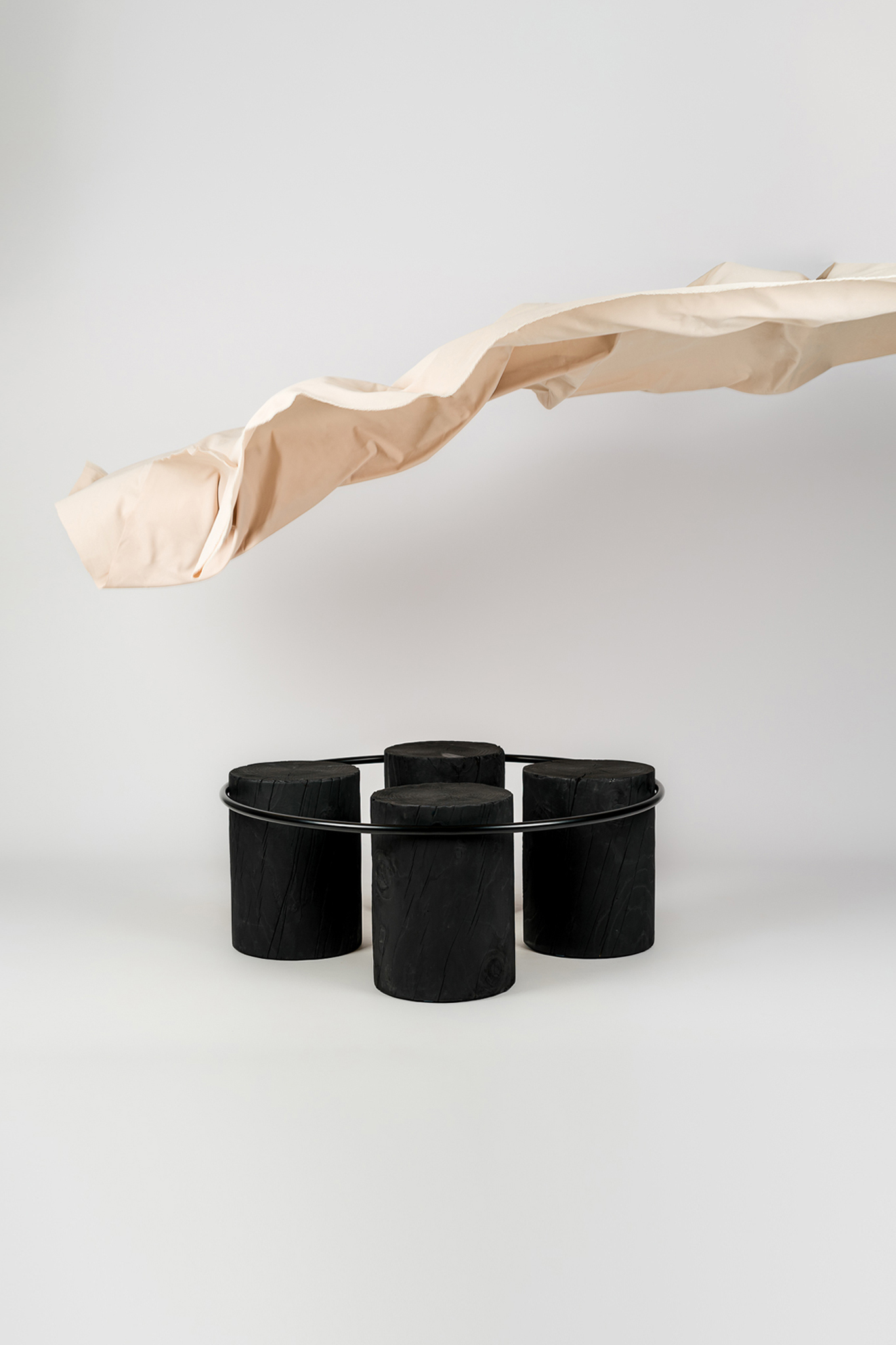
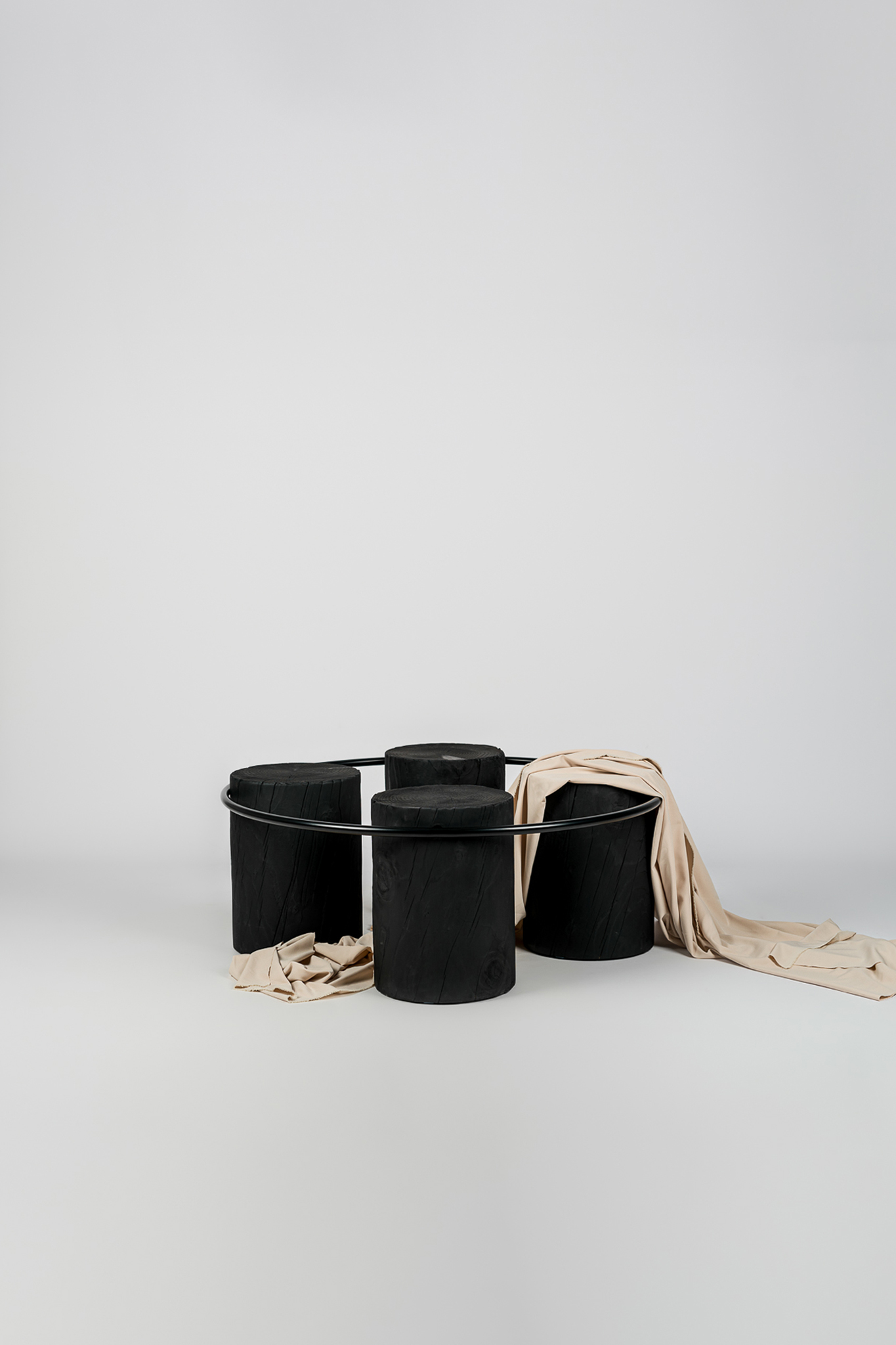

ph: ©Emanuele Chiaverini
2025__Vestigia Collectible Exhibitions
![]()
Design in a Real World celebrates the connection between design and the Tuscan territory, a destination from which many of the participating designers originate, and one historically synonymous with a rich craftsmanship legacy. As evoked by the exhibition’s title, the territory – the ‘real world’ – is contrasted with the constructed, artificial, and often frenetic identity of the city and industrial design. The exhibition, therefore, focuses on a slower, localised, and more reflective artisanal perspective that characterises both the designers’ works and life outside the populated urban centres.
Exhibitions

Design in a Real World celebrates the connection between design and the Tuscan territory, a destination from which many of the participating designers originate, and one historically synonymous with a rich craftsmanship legacy. As evoked by the exhibition’s title, the territory – the ‘real world’ – is contrasted with the constructed, artificial, and often frenetic identity of the city and industrial design. The exhibition, therefore, focuses on a slower, localised, and more reflective artisanal perspective that characterises both the designers’ works and life outside the populated urban centres.
curator: Jonathan Bocca
location: Villa Marie
text: Federica Sala
pr: Cora Pr / Cora Manzi



ph: ©Dario Borruto
2025__ORObyRUFFINO__Triennale Milano Exhibitions
Inspired by the iconic Ruffino Chianti Classico Gran Selezione Riserva Ducale Oro and Italian
design, the project unites creative talents and exceptional wines in a journey of art and
innovation.
Ruffino fosters a unique creative energy with Triennale Milano. Five artists have been invited to interpret the art of connection, creating exclusive works that transform conviviality into art. Their creations express a personal artistic vision and a deep connection to gold, which has always symbolized transformation and elevation.
The table becomes a place for encounters and exchanges, where ideas are born and inspiration takes shape. Thoughts, flavors and colors intertwine, turning the ritual of conviviality into a creative workshop that celebrates Italian craftsmanship and excellence.
For this edition, Marco Sammicheli, Director of the Museum of Italian Design at Triennale Milano, has selected five studios capable of exploring and reinterpreting objects, materials and forms from a personal perspective, leading to creations that tell the story of Italian design from new angles.
Agustina Bottoni, Beatrice Dettori, Studio Martinelli Venezia, Millim Studio and Uroš Mihić each shape unique works that explore the connection between design, conviviality and fine wines, using a personal language and an innovative vision. These creations reveal their full essence within an environment expertly designed by the architectural studio B-Arch, which has woven a perfect connection between space and design.
![]()
![]()
![]()
![]()
ph: ©Liligutt Studio
Exhibitions
![]()
ph: ©Liligutt Studio
video: ©Giuseppe Cardaci
![]()
![]()
ORObyRUFFINO
Triennale Milano
a project by Ruffino
curated by Triennale Milano / Marco Sammicheli
agency: PLUS+
pr agency: Allumeuse
exhibition design: B-Arch
ph: ©Liligutt Studio
Inspired by the iconic Ruffino Chianti Classico Gran Selezione Riserva Ducale Oro and Italian
design, the project unites creative talents and exceptional wines in a journey of art and
innovation.

Ruffino fosters a unique creative energy with Triennale Milano. Five artists have been invited to interpret the art of connection, creating exclusive works that transform conviviality into art. Their creations express a personal artistic vision and a deep connection to gold, which has always symbolized transformation and elevation.
The table becomes a place for encounters and exchanges, where ideas are born and inspiration takes shape. Thoughts, flavors and colors intertwine, turning the ritual of conviviality into a creative workshop that celebrates Italian craftsmanship and excellence.
For this edition, Marco Sammicheli, Director of the Museum of Italian Design at Triennale Milano, has selected five studios capable of exploring and reinterpreting objects, materials and forms from a personal perspective, leading to creations that tell the story of Italian design from new angles.
Agustina Bottoni, Beatrice Dettori, Studio Martinelli Venezia, Millim Studio and Uroš Mihić each shape unique works that explore the connection between design, conviviality and fine wines, using a personal language and an innovative vision. These creations reveal their full essence within an environment expertly designed by the architectural studio B-Arch, which has woven a perfect connection between space and design.




ph: ©Liligutt Studio
www.ruffino.com
2025__CAN YOU IMAGINE?__Secondome__Rossana Orlandi
![]()
A ode to Imagination and its positive transformative power.
In an era that over the last 50 years has been increasingly marked by a justified sense of global concern over the state of the world, Can You Imagine? seeks to promote creativity as a central and positive force to driving future scenarios. This concept is reaffirmed through the visionary title of a 70s science fiction novel ‘Out of their minds” (USA, 1970, Clifford D. Simak), in which men, through the power of their imagination, create countless beginnings. Since then to current times, imagination has continued to transform the impossible into possible.
Through creativity and the courage to “use their heart to overcome difficulty”, the exhibition’s designers — Onka Allmayer-Beck, CContinua + Mamt, Clementine Chambon, Serena Confalonieri, Millim Studio, and Matteo Pellegrino — are invited to explore the role of imagination in current times.
Are we still able to imagine?
In a world soaked in realism—from literature to cinema—where “based on a true story” prevail above and beyond the story’s ability to spark thought; where journalism must navigate the dangerous waters of fake news; and where design seems focused on the artificial imitation of natural materials (and here the mind jumps to Blade Runner’s snakeskin) — are we still able to think outside the box?
What’s more, in observing the growing tension between what’s true and what’s false, fuelled all the more by the increasing capacity of AI, what role do we assign to creativity?
Certainly not that of inventing fantasy worlds as an escape from a dystopian reality, but rather that of imagining.
Imagining a different future.
Imagining different homes.
Imagining different people.
Imagining different objects.
And I’m certain that as you read the word imagine, your mind is already humming to the tune of The Cranberries, John Lennon, or perhaps even Ligabue.
This is a small collection of objects and furnishings that don’t claim to change the world, but that firmly refuse to stay grounded, raising their heads proudly towards the clouds.
Federica Sala (curator)
![]()
Exhibitions

![]()
CAN YOU IMAGINE?
Galleria Rossana Orlandi, Milan
a project by Secondome
curated by Federica Sala
ph: ©Eller Studio ©Serena Eller
A ode to Imagination and its positive transformative power.
In an era that over the last 50 years has been increasingly marked by a justified sense of global concern over the state of the world, Can You Imagine? seeks to promote creativity as a central and positive force to driving future scenarios. This concept is reaffirmed through the visionary title of a 70s science fiction novel ‘Out of their minds” (USA, 1970, Clifford D. Simak), in which men, through the power of their imagination, create countless beginnings. Since then to current times, imagination has continued to transform the impossible into possible.
Through creativity and the courage to “use their heart to overcome difficulty”, the exhibition’s designers — Onka Allmayer-Beck, CContinua + Mamt, Clementine Chambon, Serena Confalonieri, Millim Studio, and Matteo Pellegrino — are invited to explore the role of imagination in current times.
Are we still able to imagine?
In a world soaked in realism—from literature to cinema—where “based on a true story” prevail above and beyond the story’s ability to spark thought; where journalism must navigate the dangerous waters of fake news; and where design seems focused on the artificial imitation of natural materials (and here the mind jumps to Blade Runner’s snakeskin) — are we still able to think outside the box?
What’s more, in observing the growing tension between what’s true and what’s false, fuelled all the more by the increasing capacity of AI, what role do we assign to creativity?
Certainly not that of inventing fantasy worlds as an escape from a dystopian reality, but rather that of imagining.
Imagining a different future.
Imagining different homes.
Imagining different people.
Imagining different objects.
And I’m certain that as you read the word imagine, your mind is already humming to the tune of The Cranberries, John Lennon, or perhaps even Ligabue.
This is a small collection of objects and furnishings that don’t claim to change the world, but that firmly refuse to stay grounded, raising their heads proudly towards the clouds.
Federica Sala (curator)
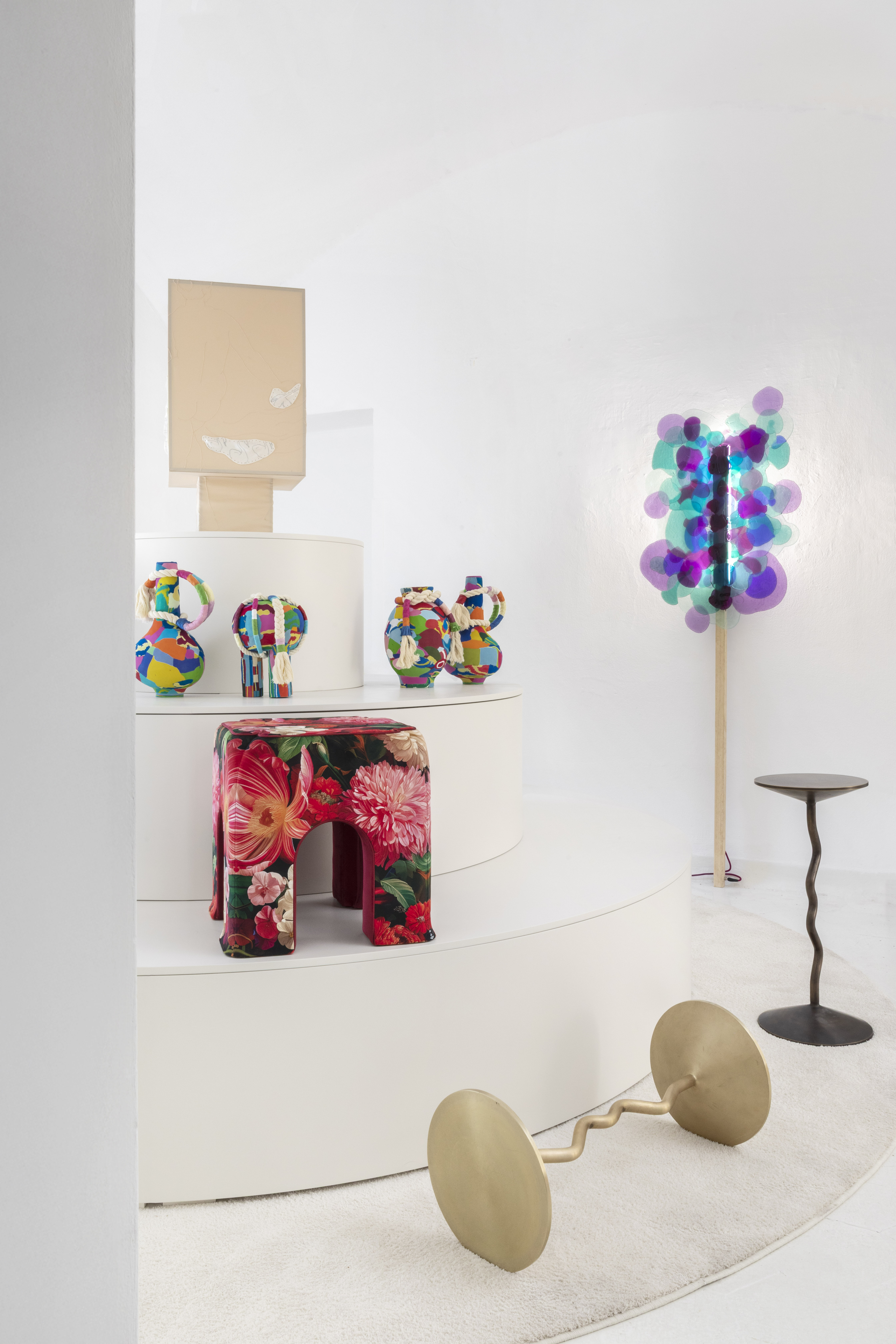
ph: ©Eller Studio ©Serena Eller
2024__Curated__Brussels Exhibitions
![]()
![]()
![]()
![]()
Curated Brussels
![]()
![]()
![]()
![]()
Exhibitions




Curated Brussels
curated by Lione Jadot
Brussles, Belgium
ph: ©Stan Huaux ©Emanuele Chiaverini




2024__Thema__Baranzate Ateliers Exhibitions
![]()
![]()
![]()
Thema
Millim Studio during Milan Design Week 2024, presents CO SERIES 01 created exclusively for Thema and showcased at Baranzate Ateliers.
CO SERIES 01 is the first of a series of sculptures/functional objects that continue the aesthetic exploration of the 'Cutout' project. This research focuses on metal shapes that have been cut out from previous projects.
![]()
![]()
![]()
![]()
![]()
![]()
Exhibitions



Thema
Baranzate Ateliers
Milan Design Week 2024
Milan, Italy
ph: ©Amber Vanbossel
Millim Studio during Milan Design Week 2024, presents CO SERIES 01 created exclusively for Thema and showcased at Baranzate Ateliers.
CO SERIES 01 is the first of a series of sculptures/functional objects that continue the aesthetic exploration of the 'Cutout' project. This research focuses on metal shapes that have been cut out from previous projects.








